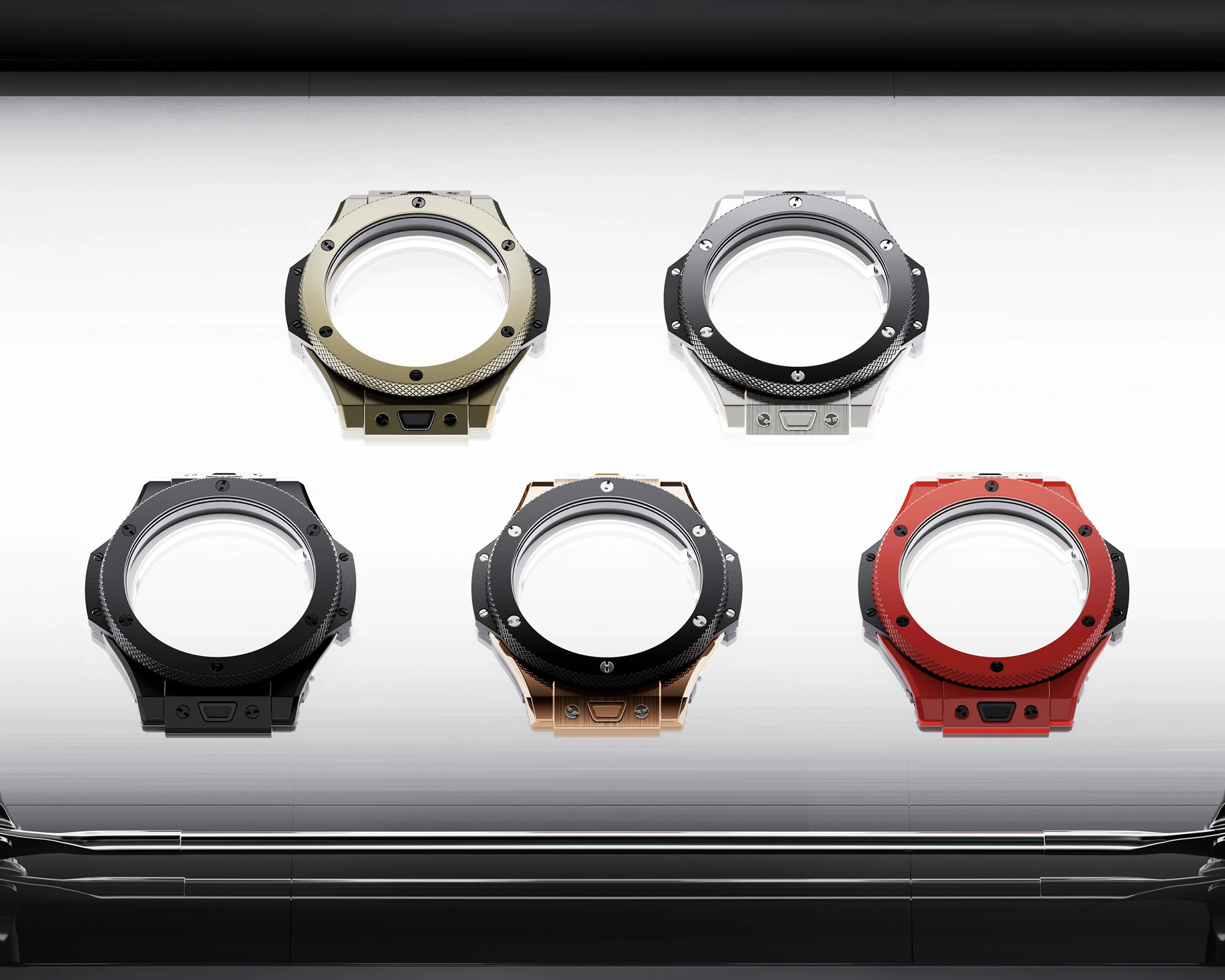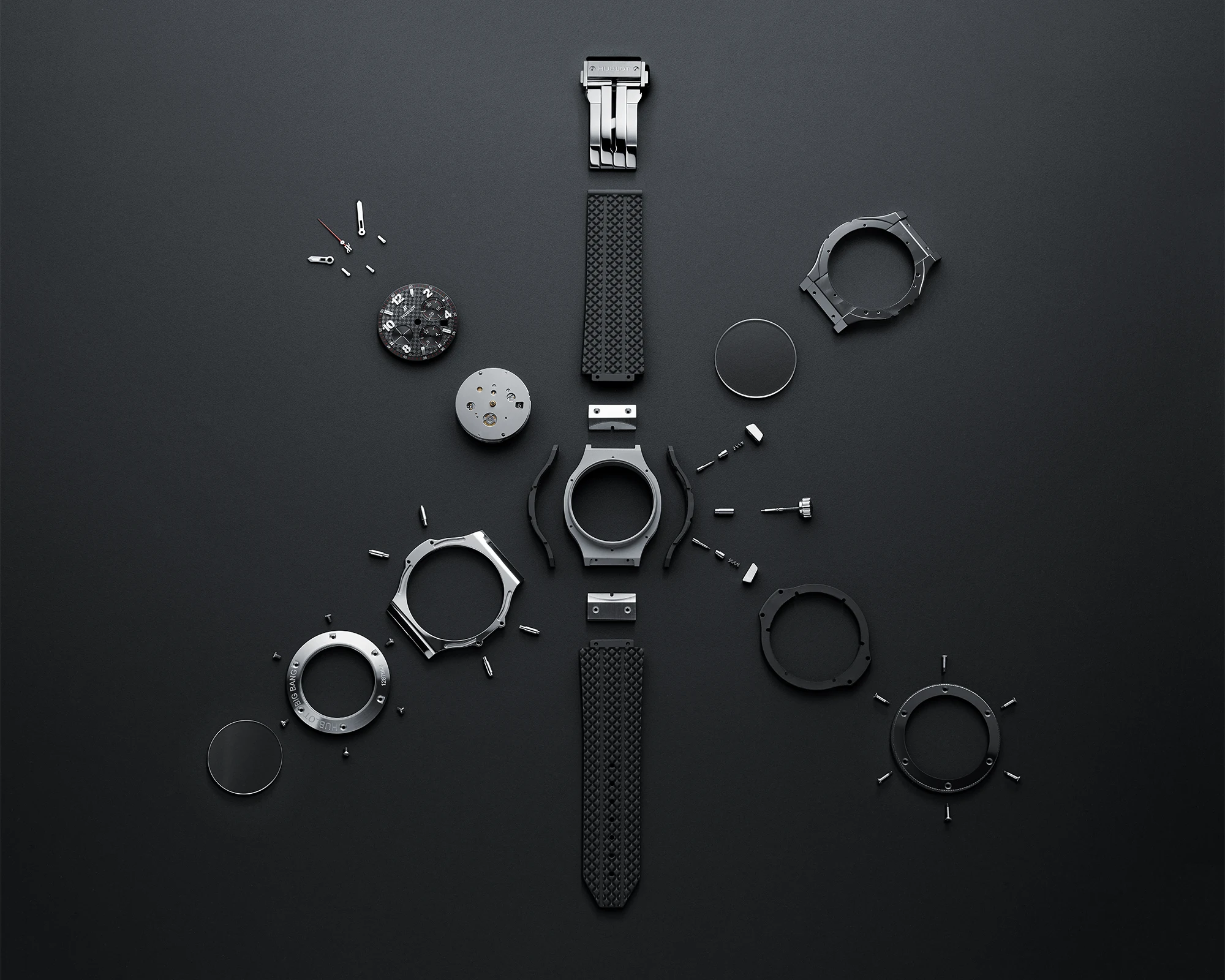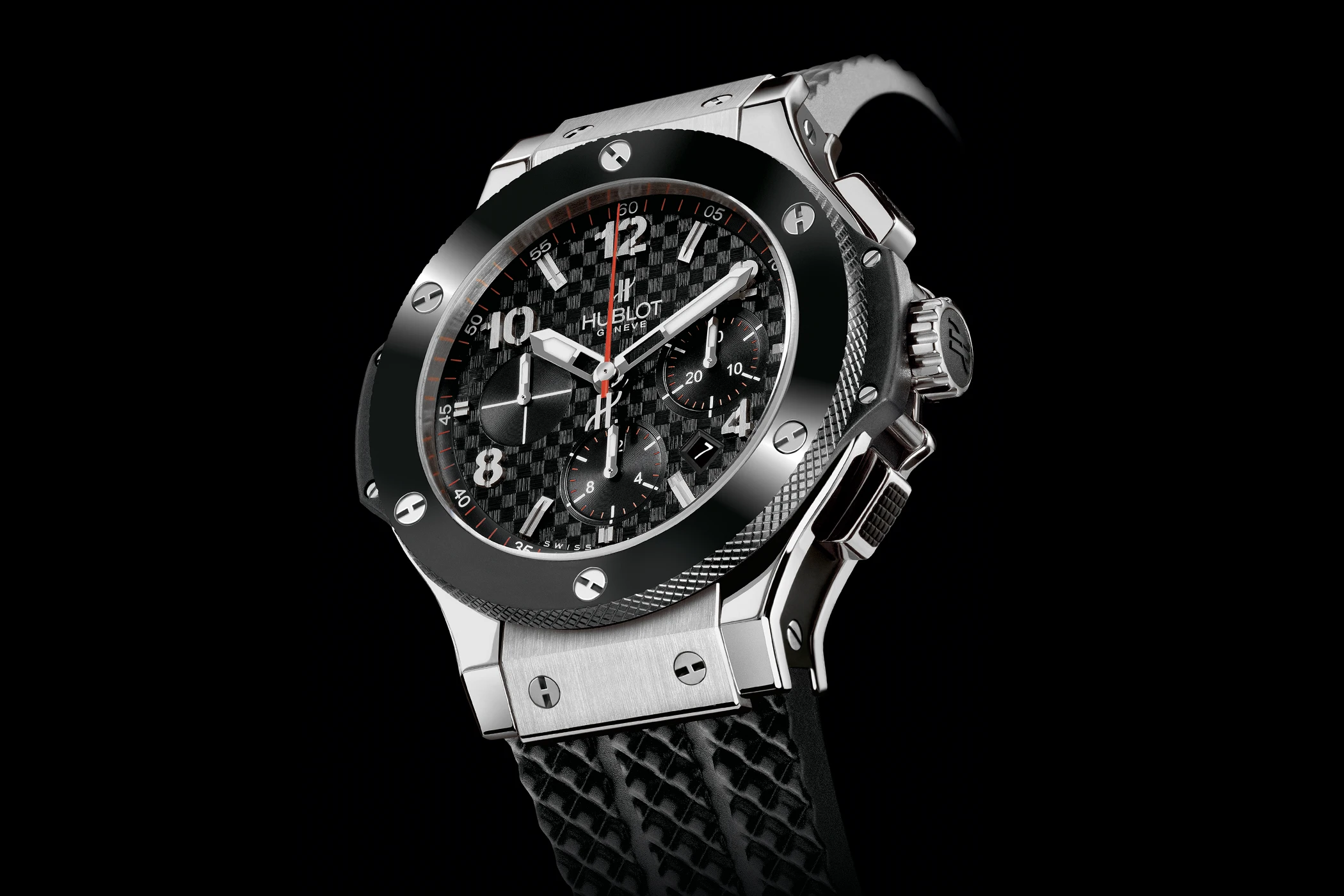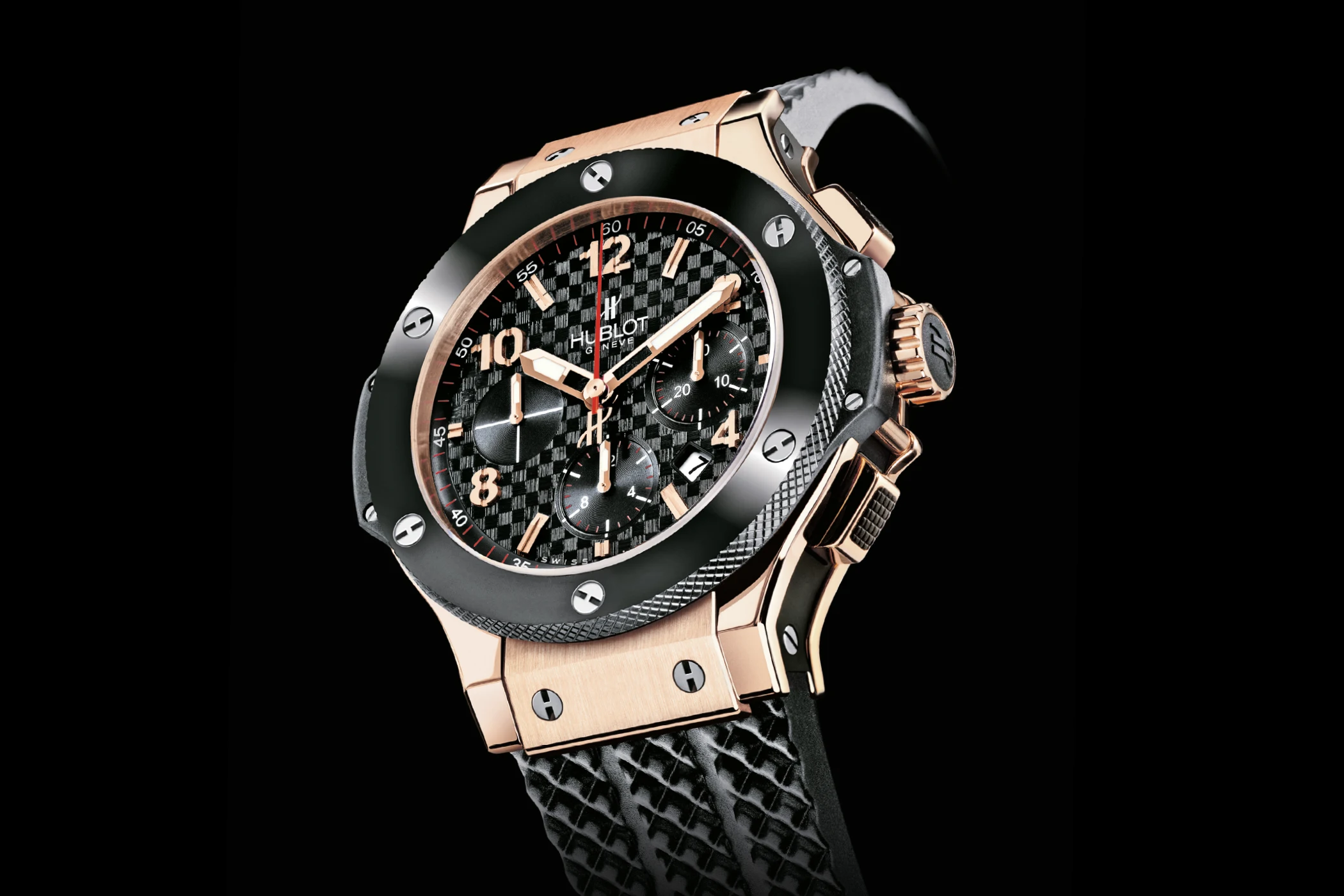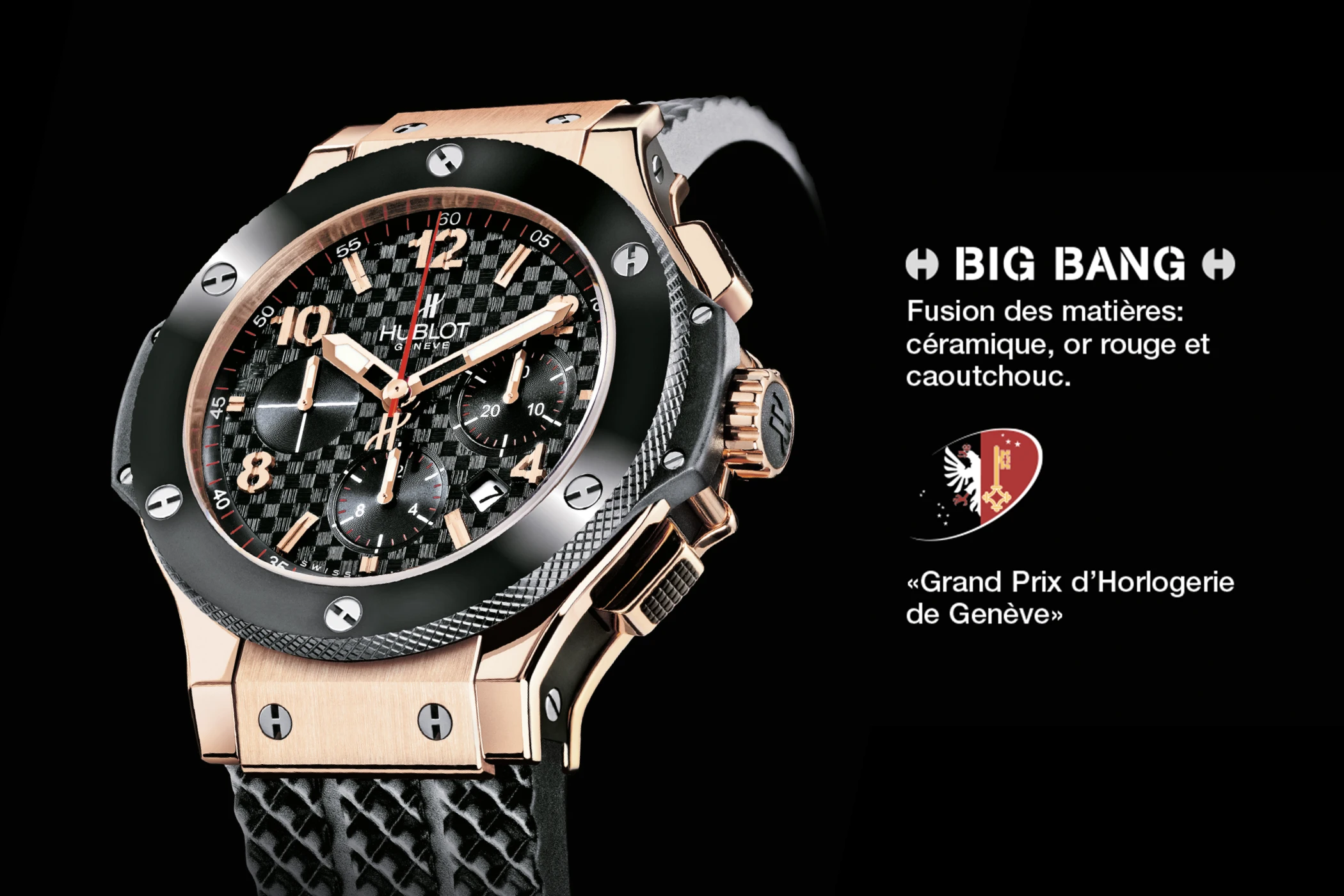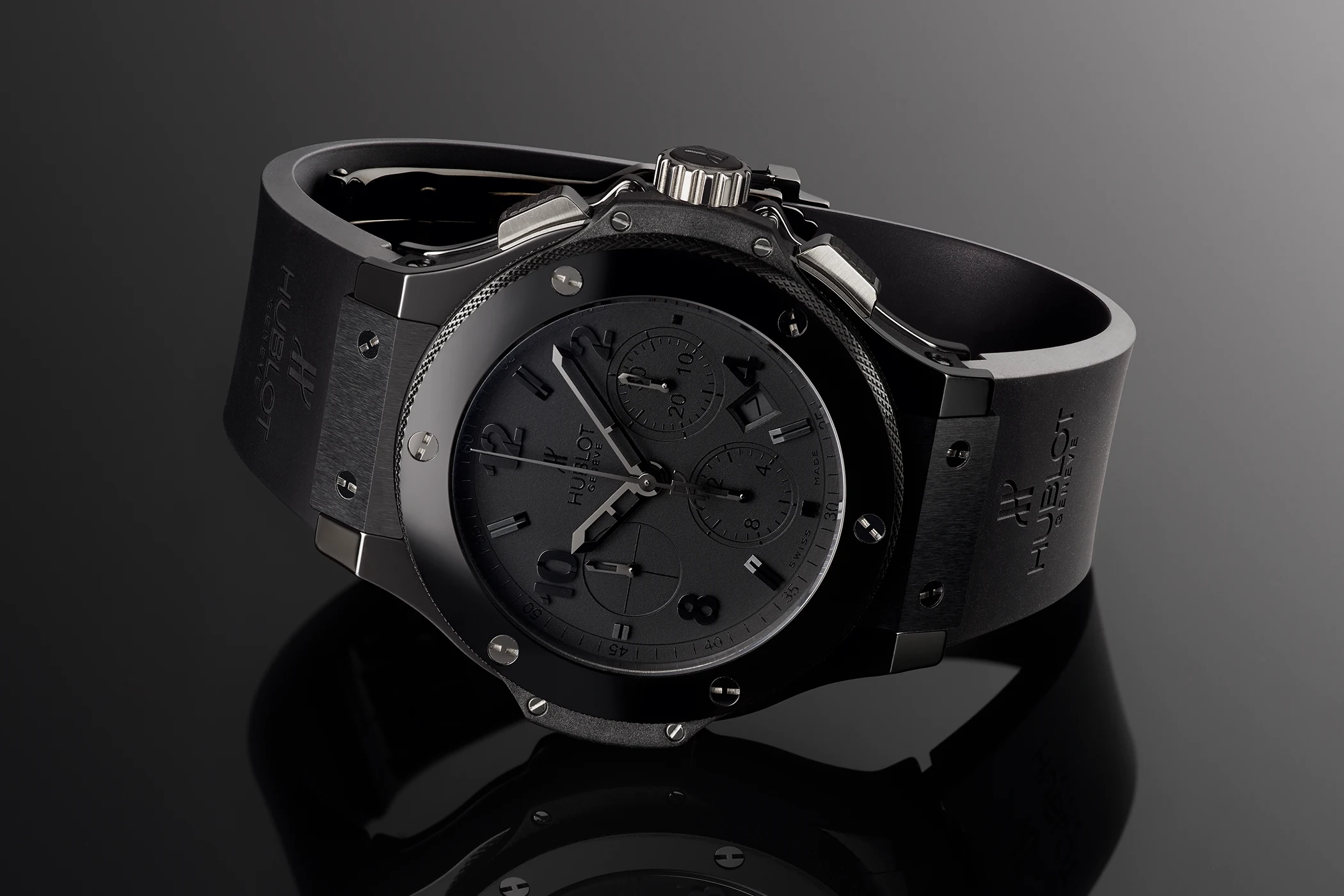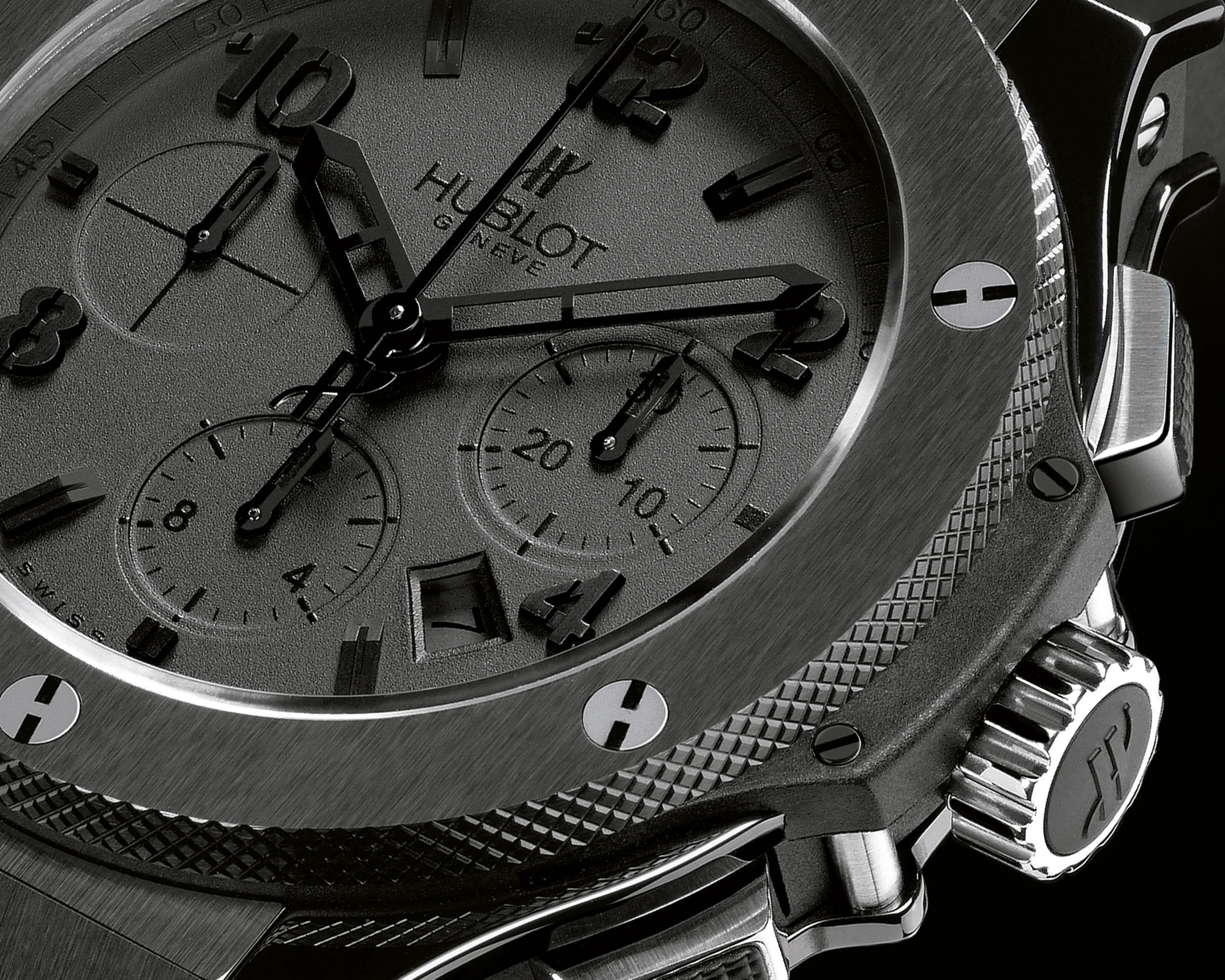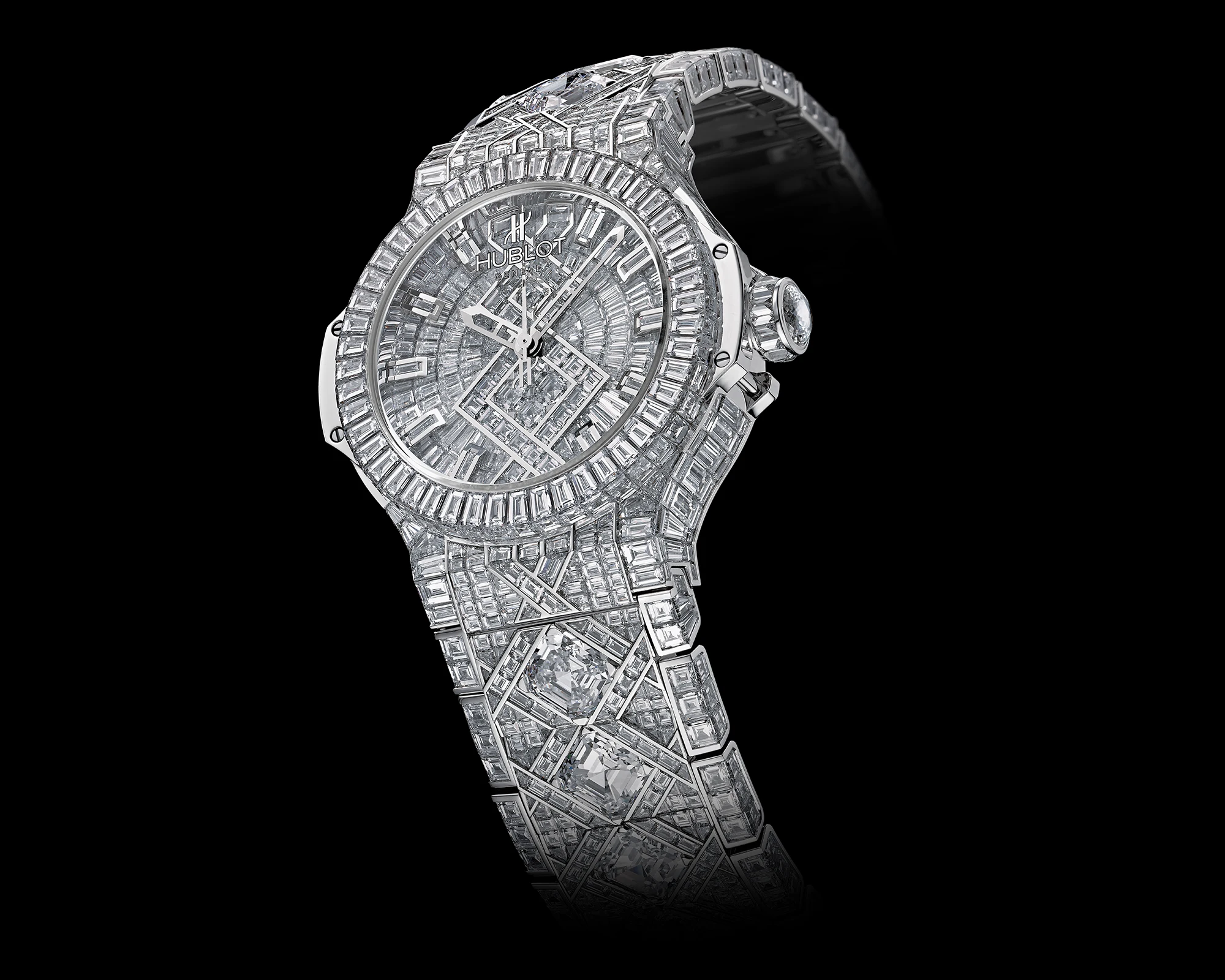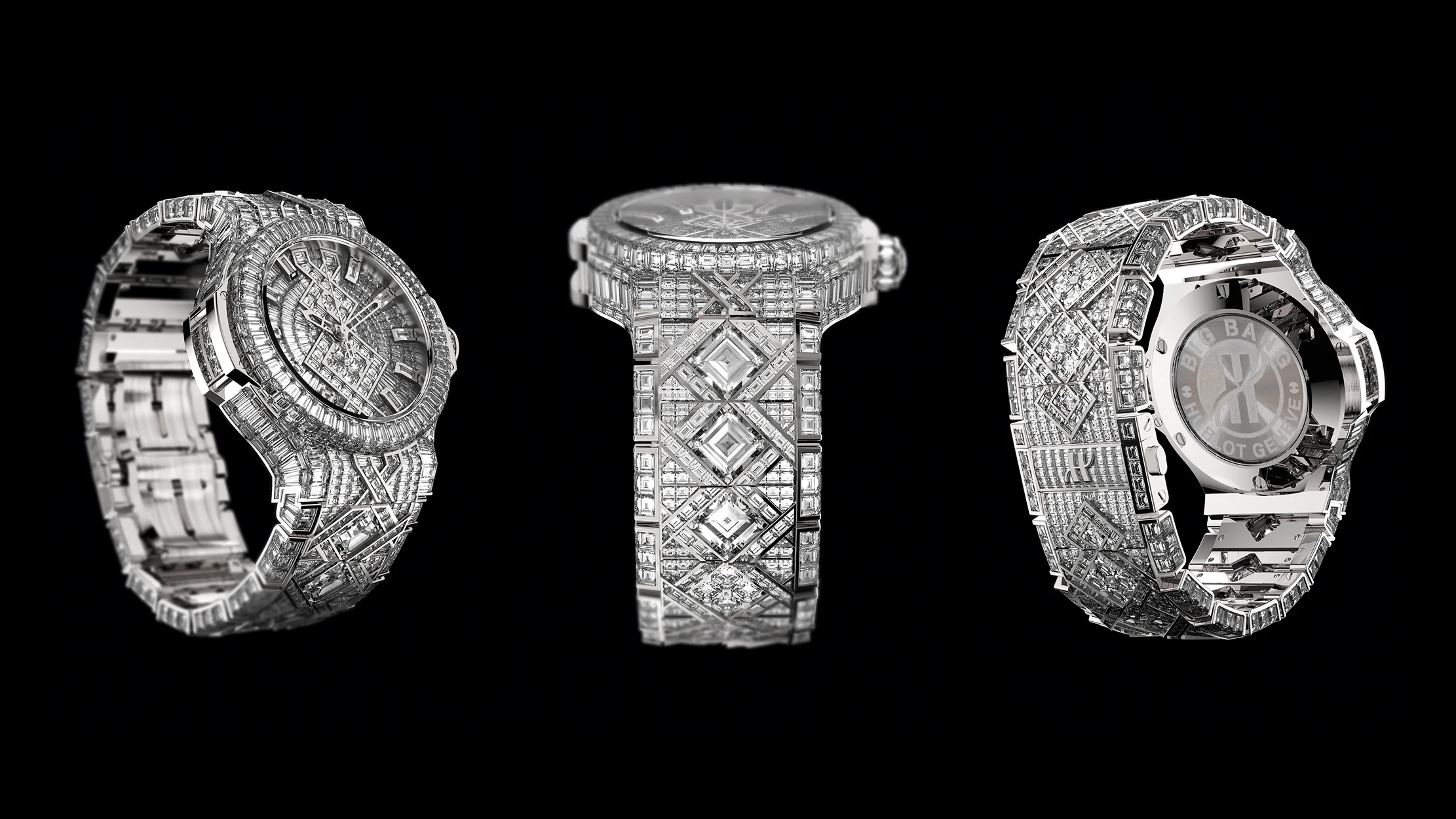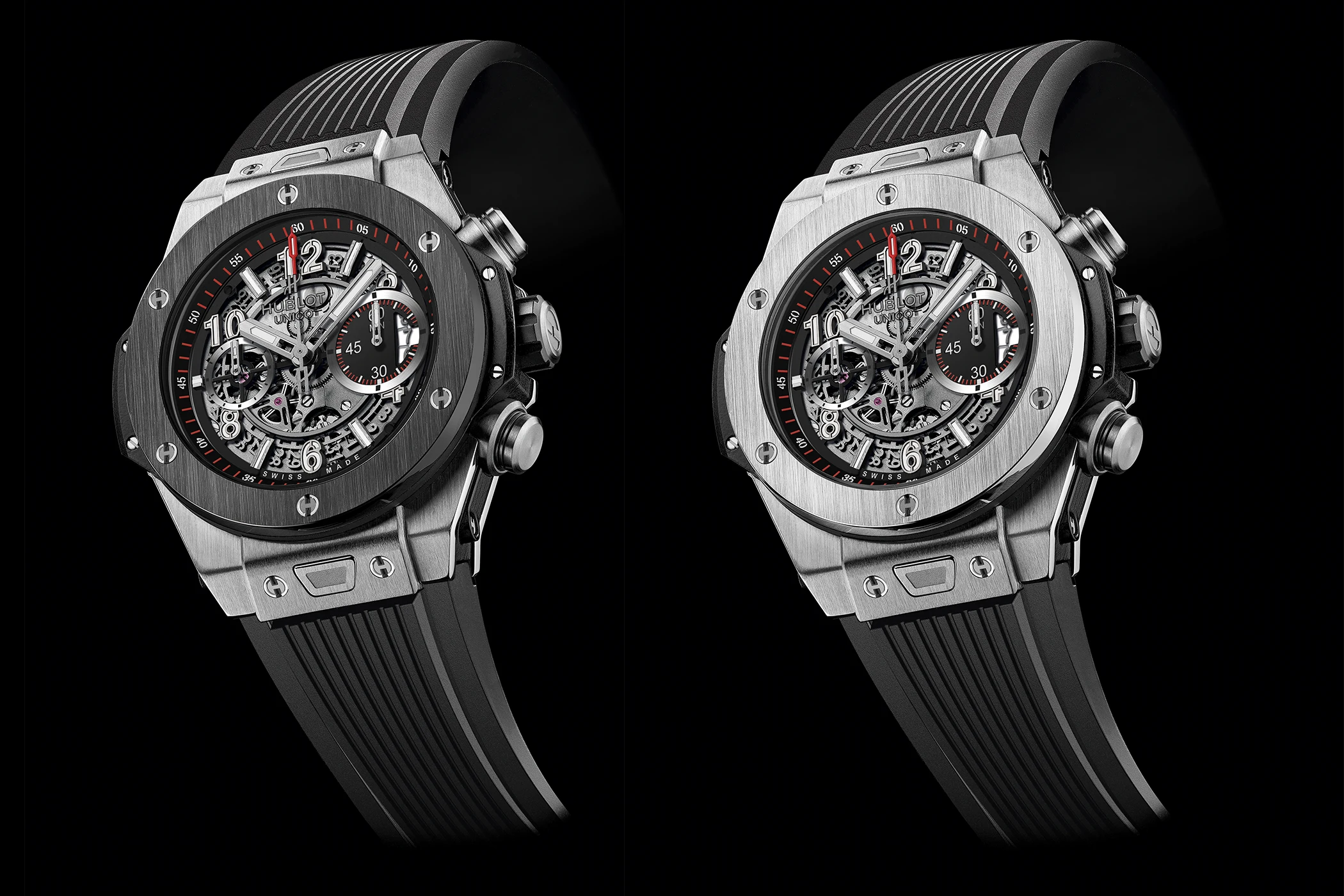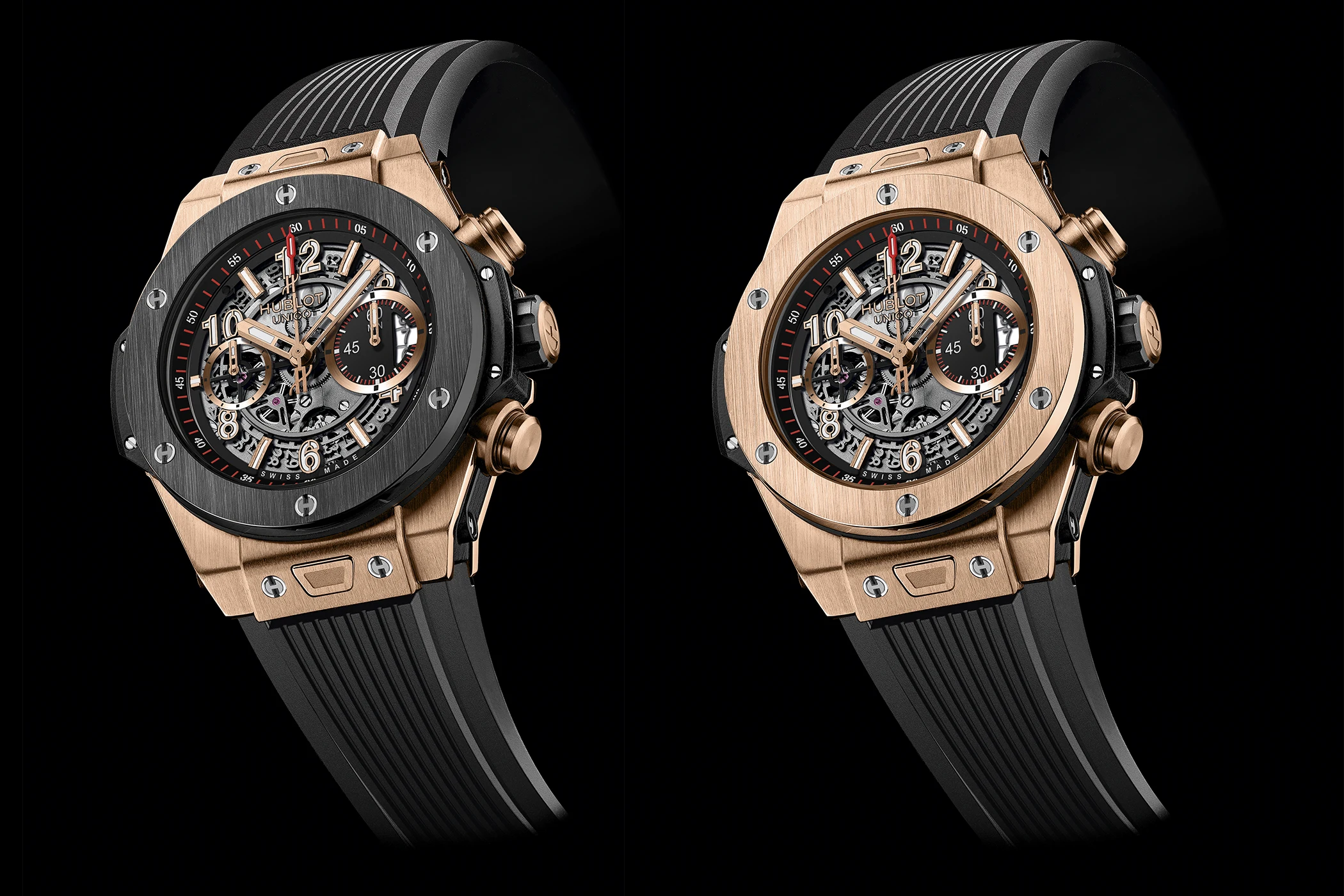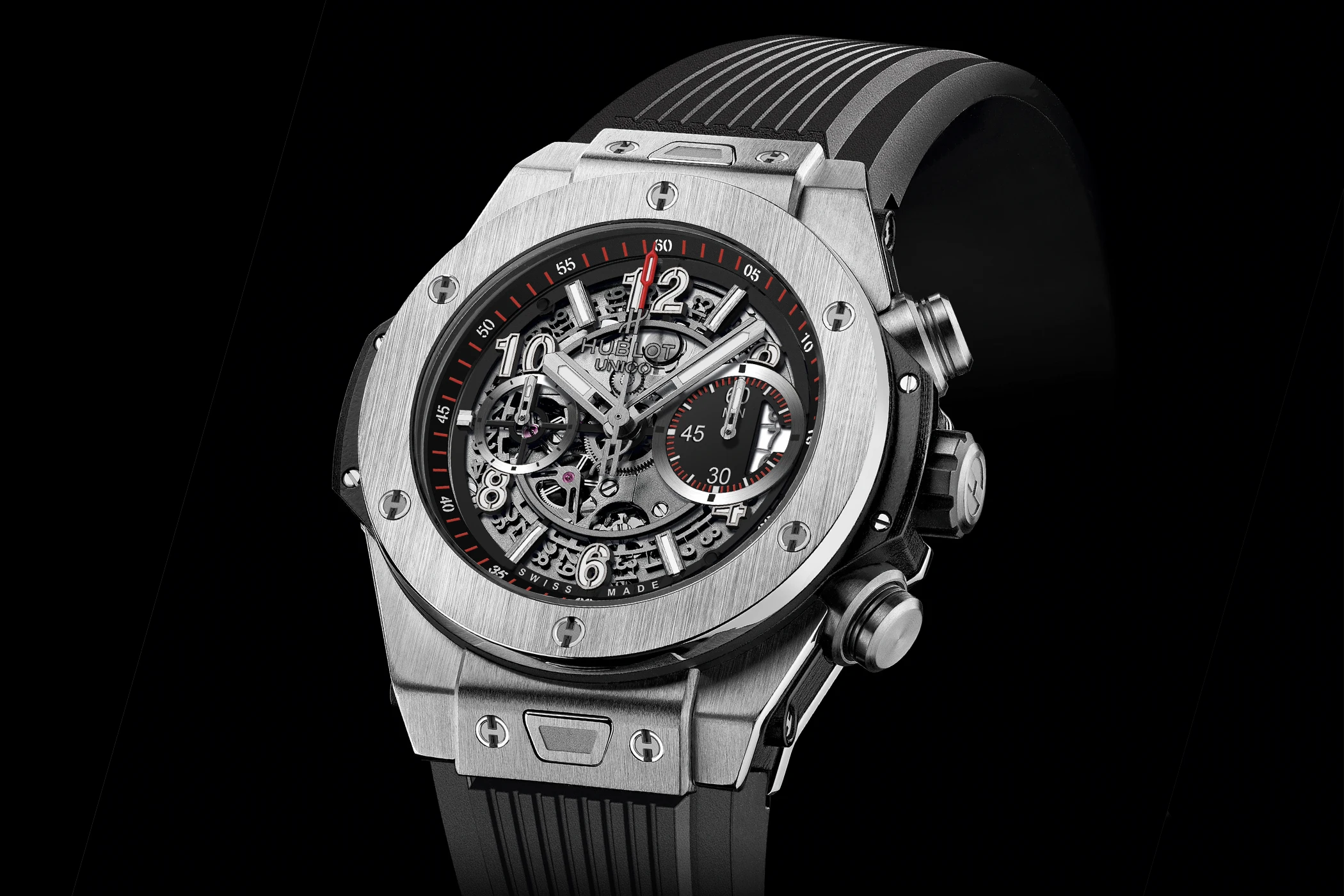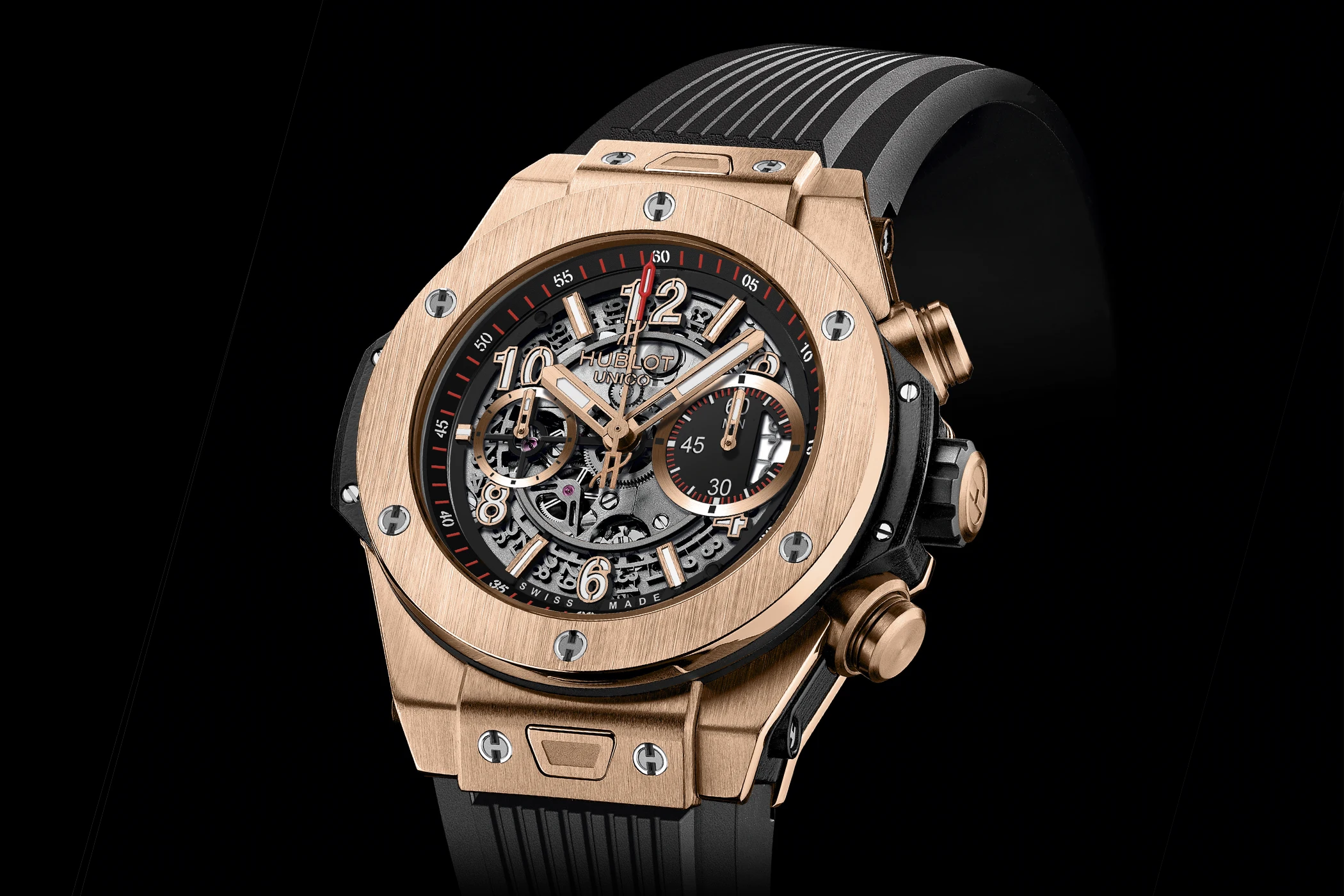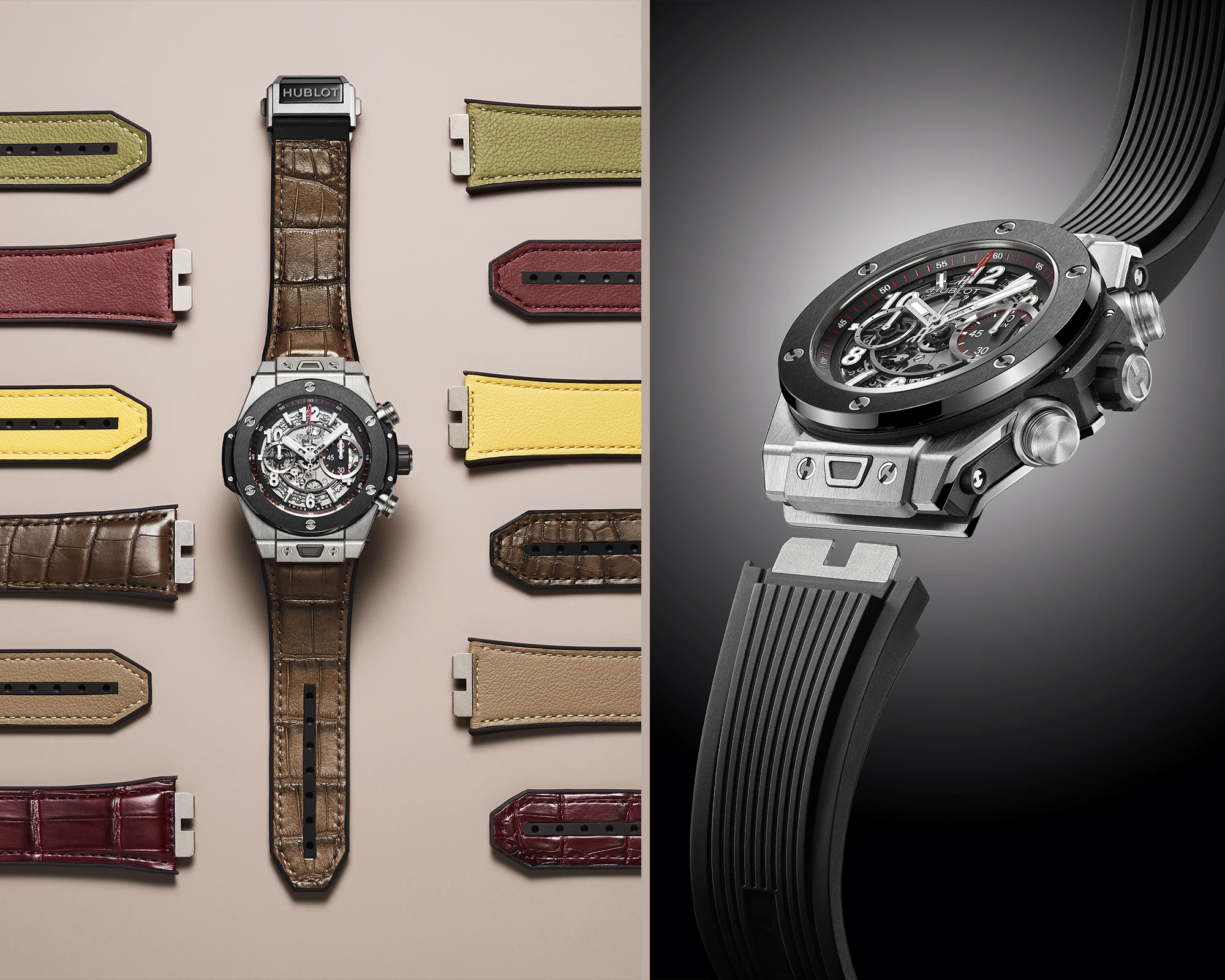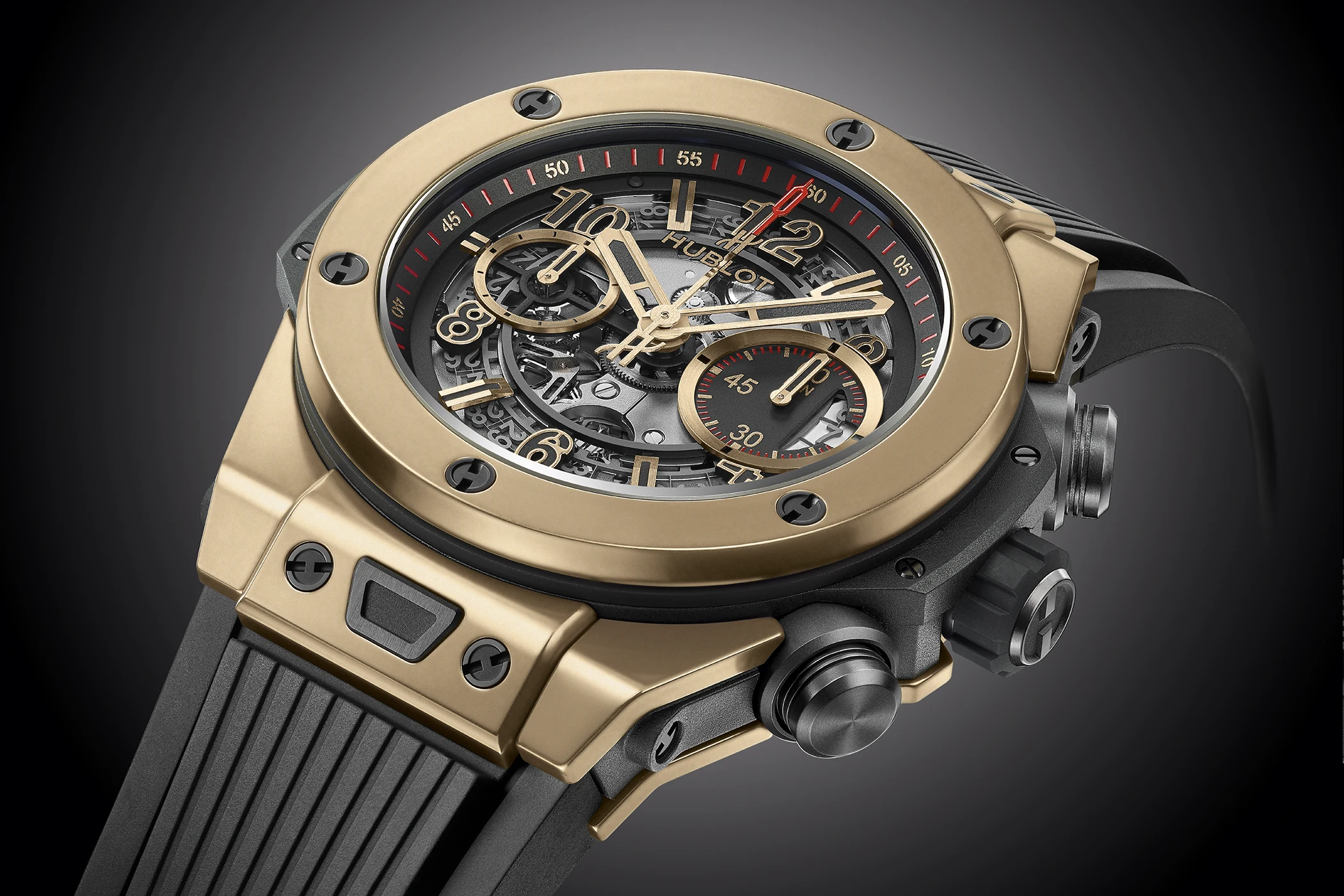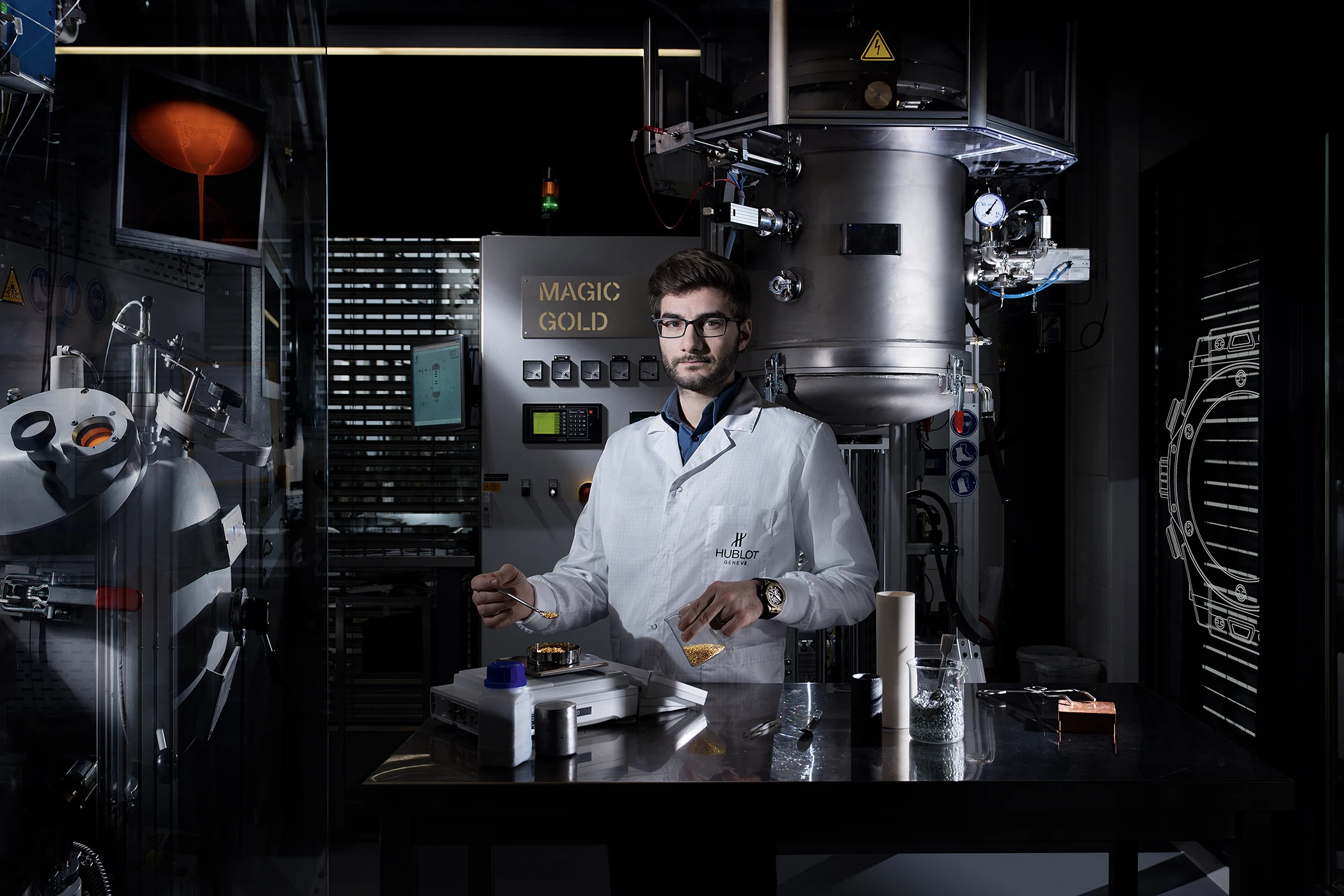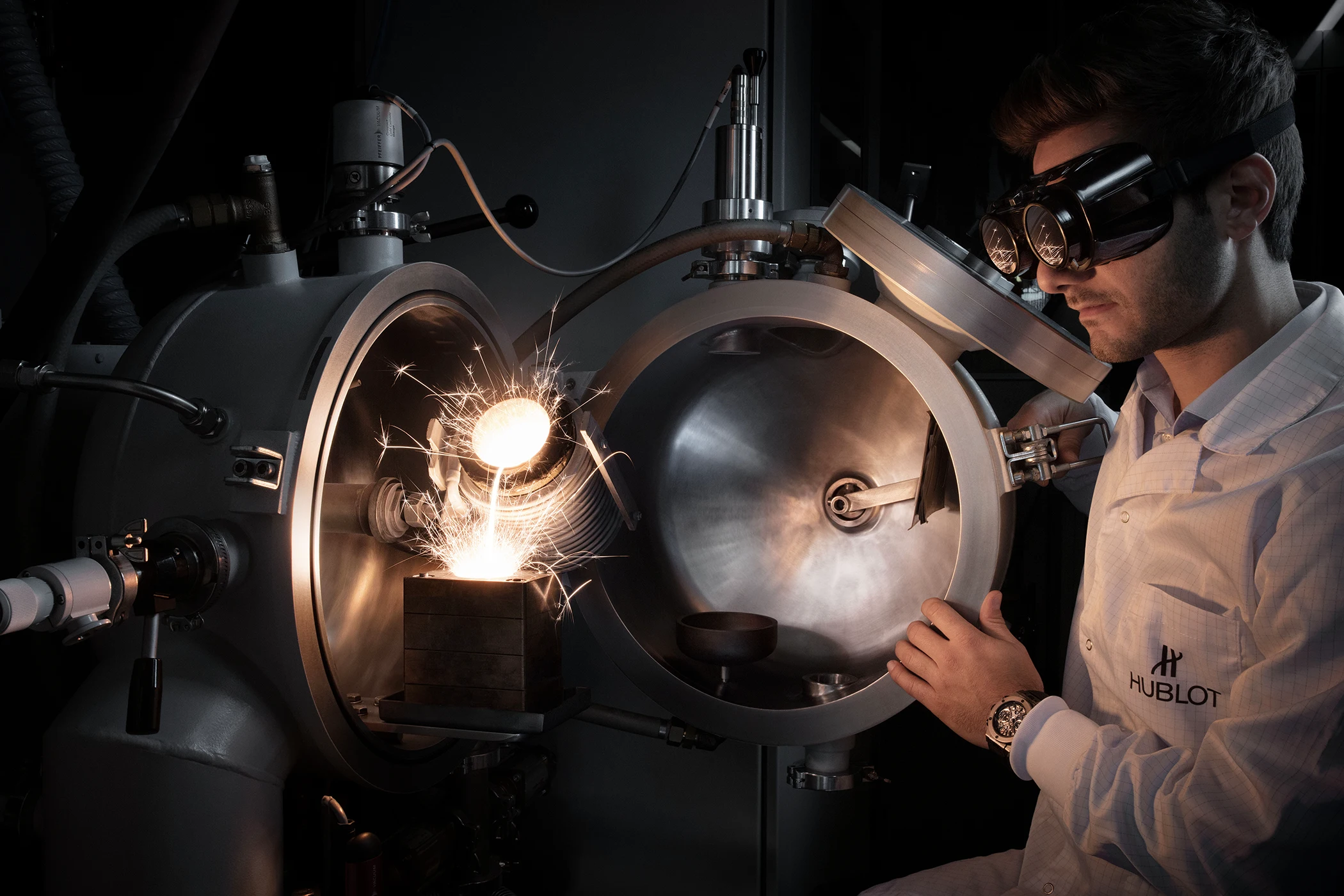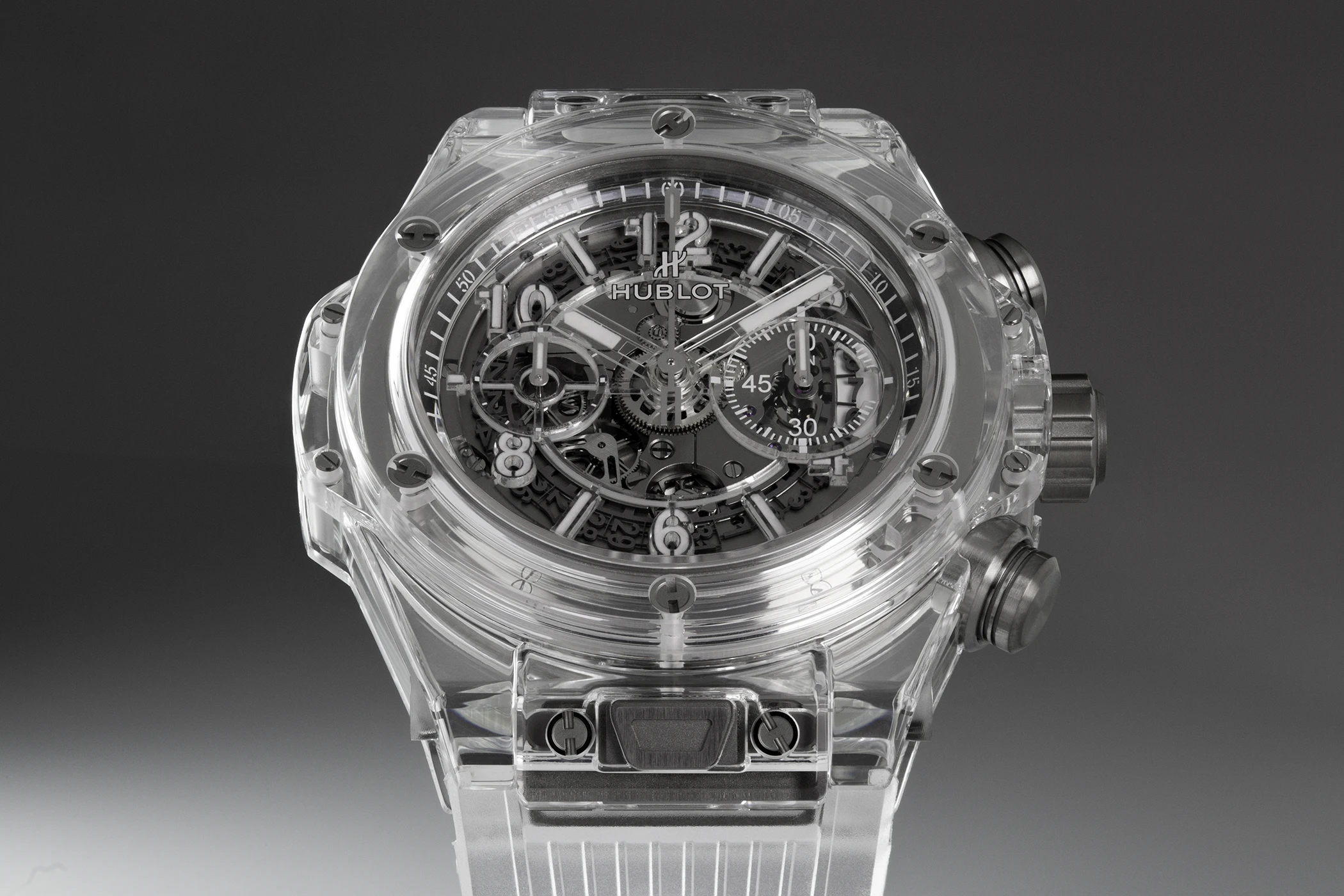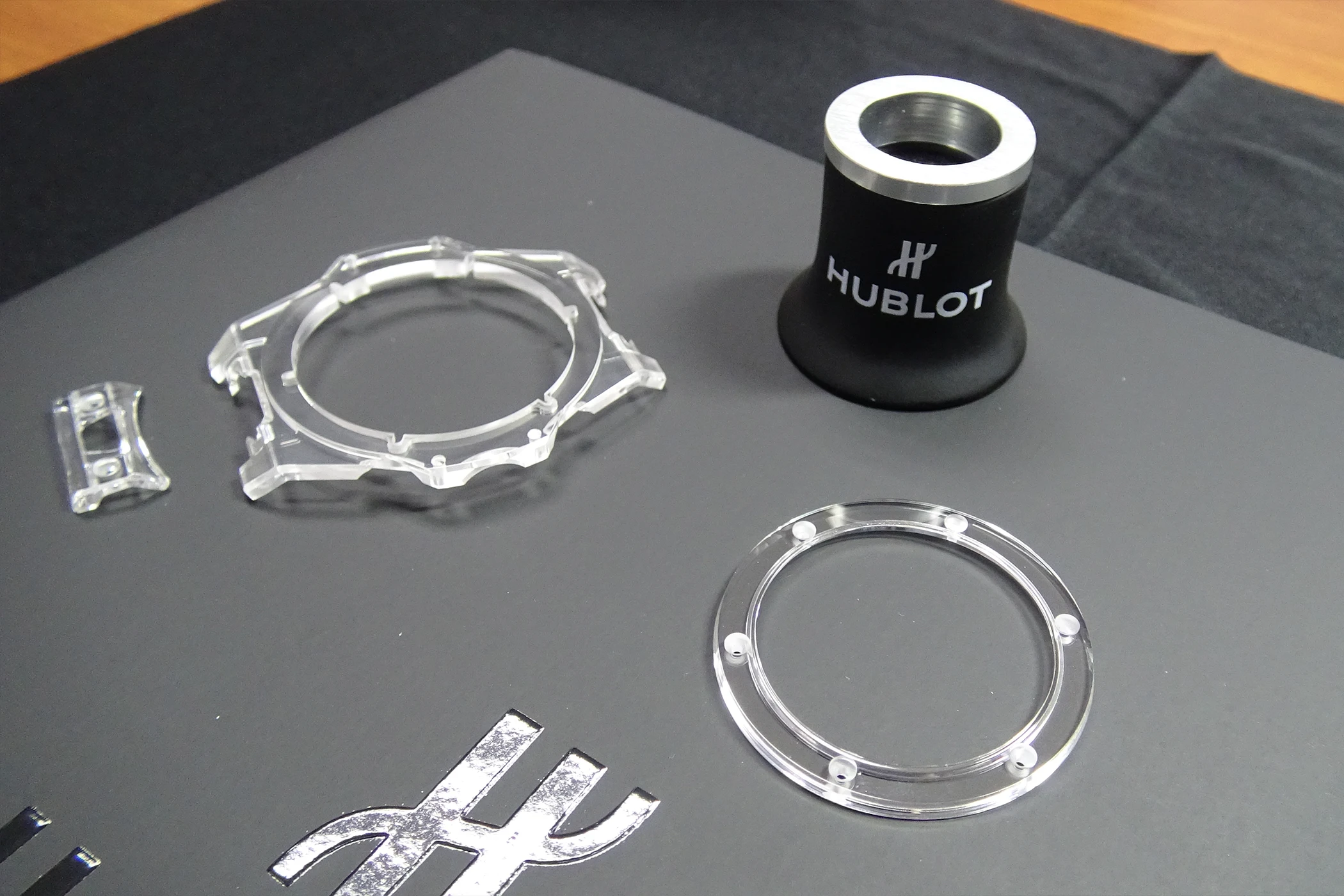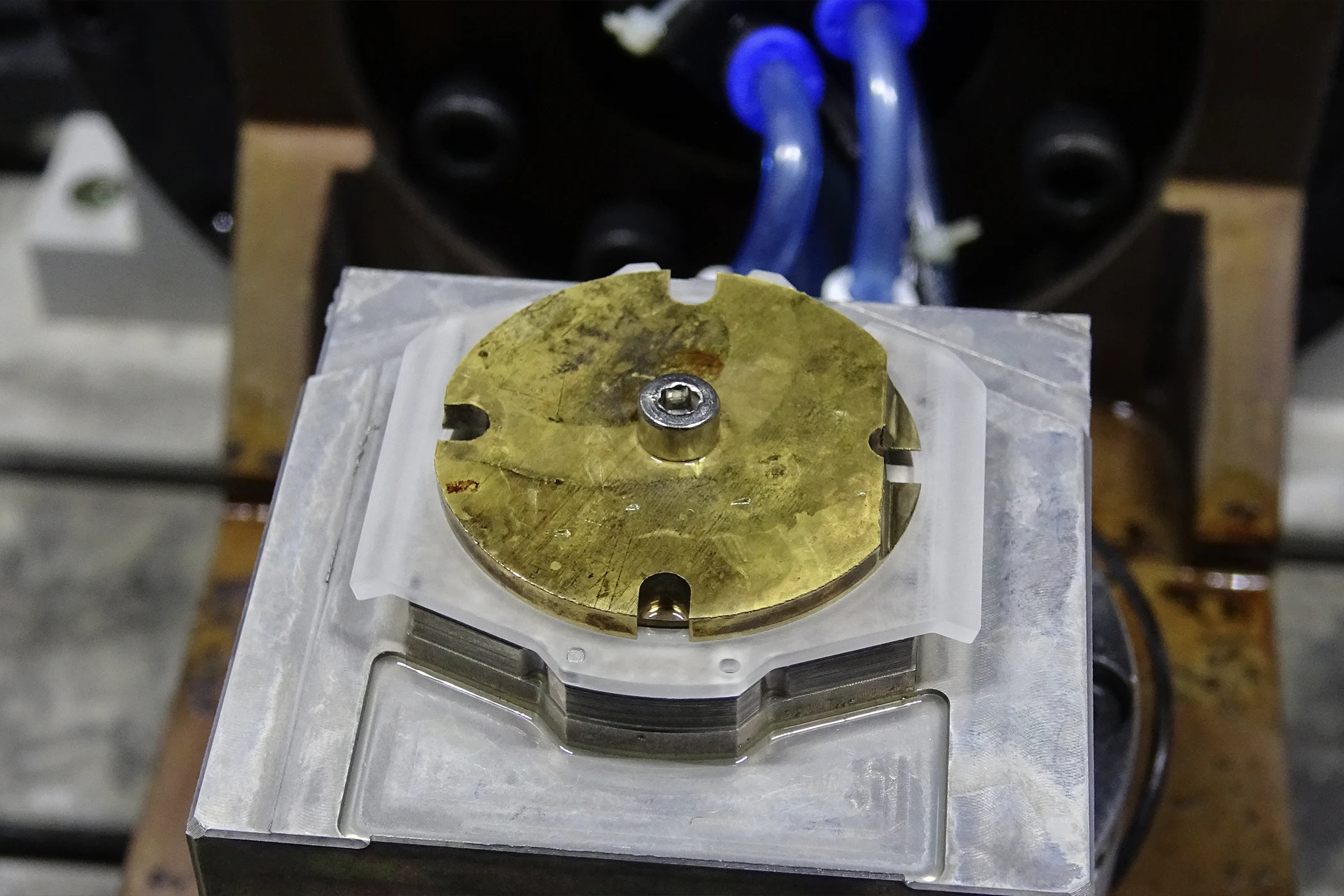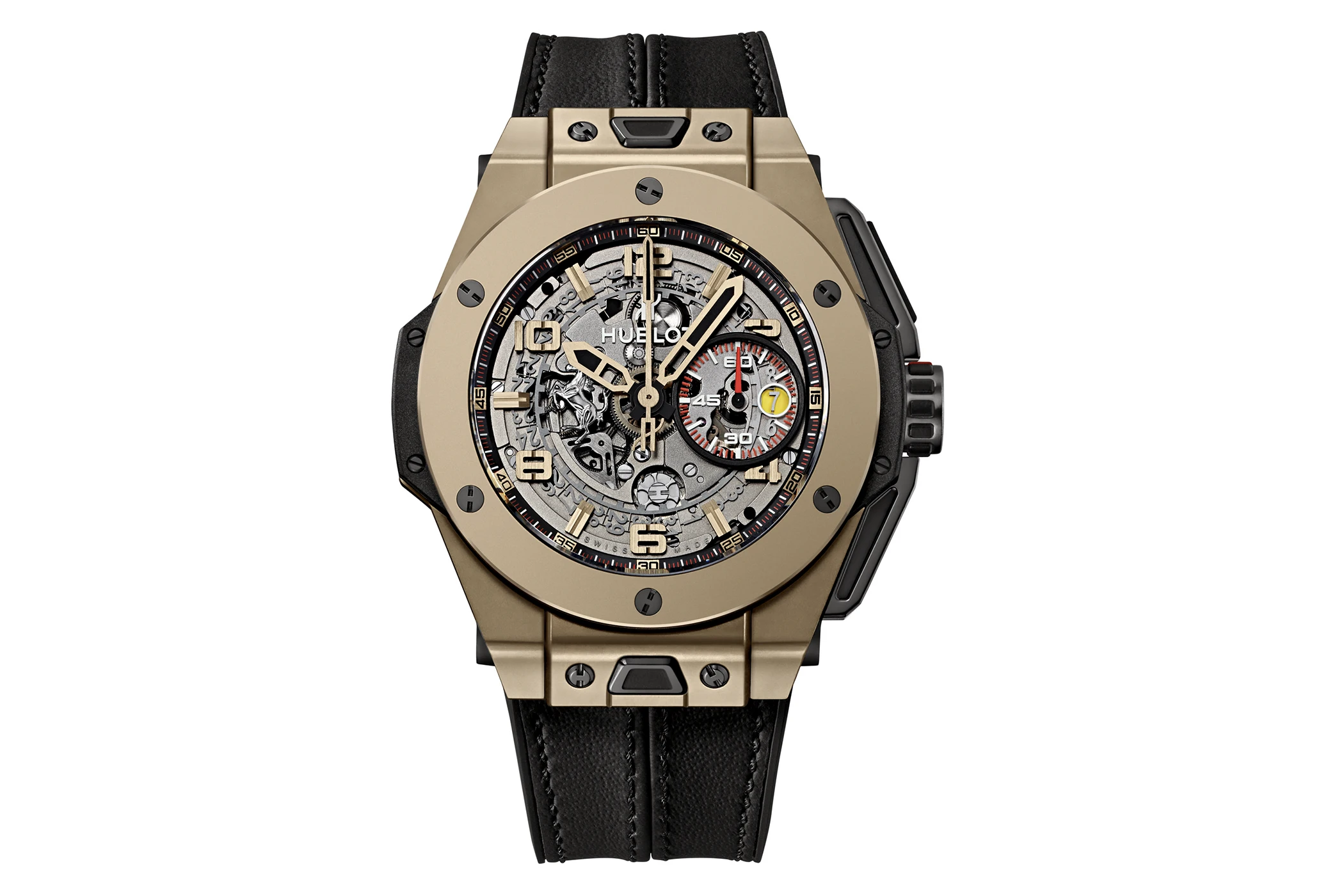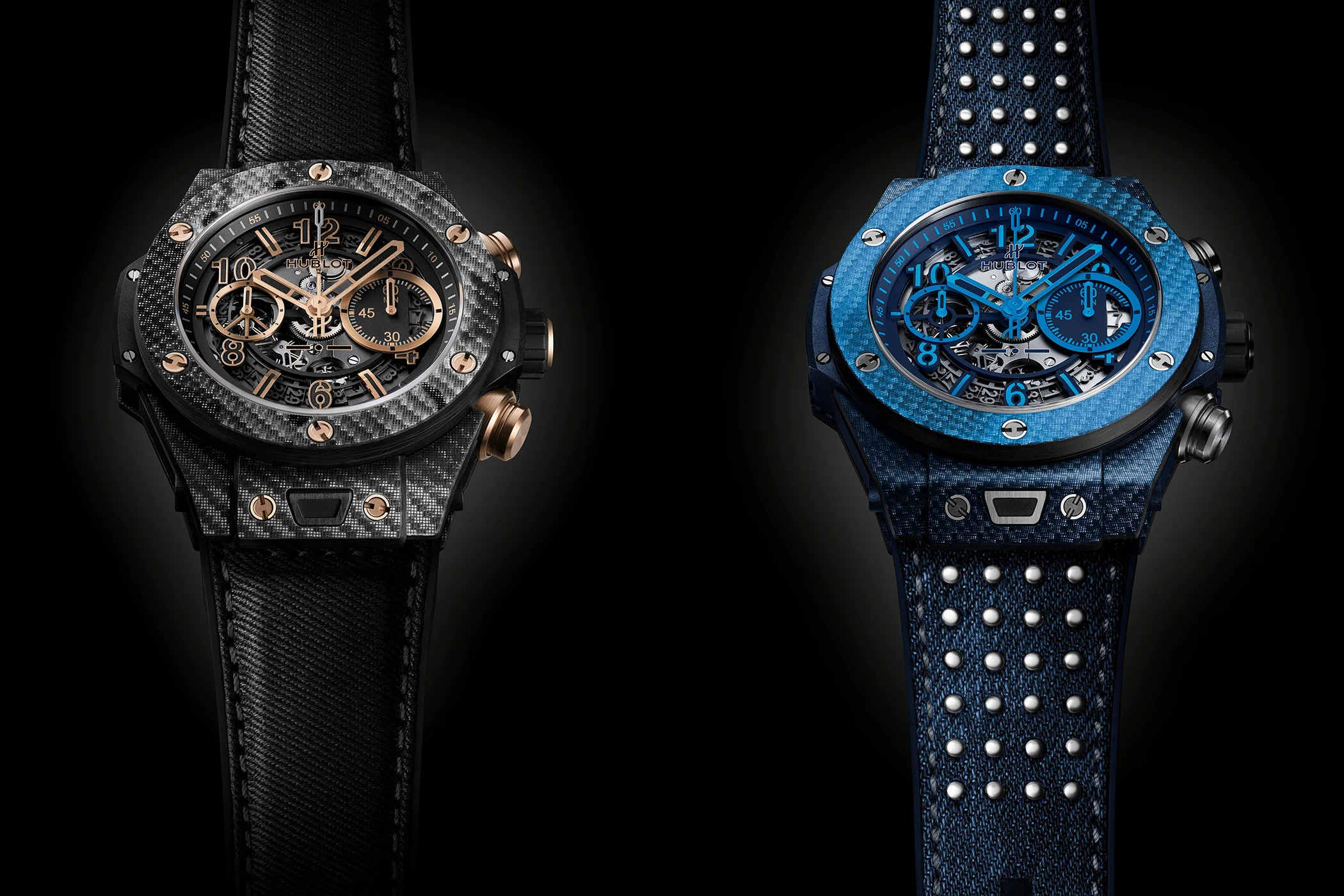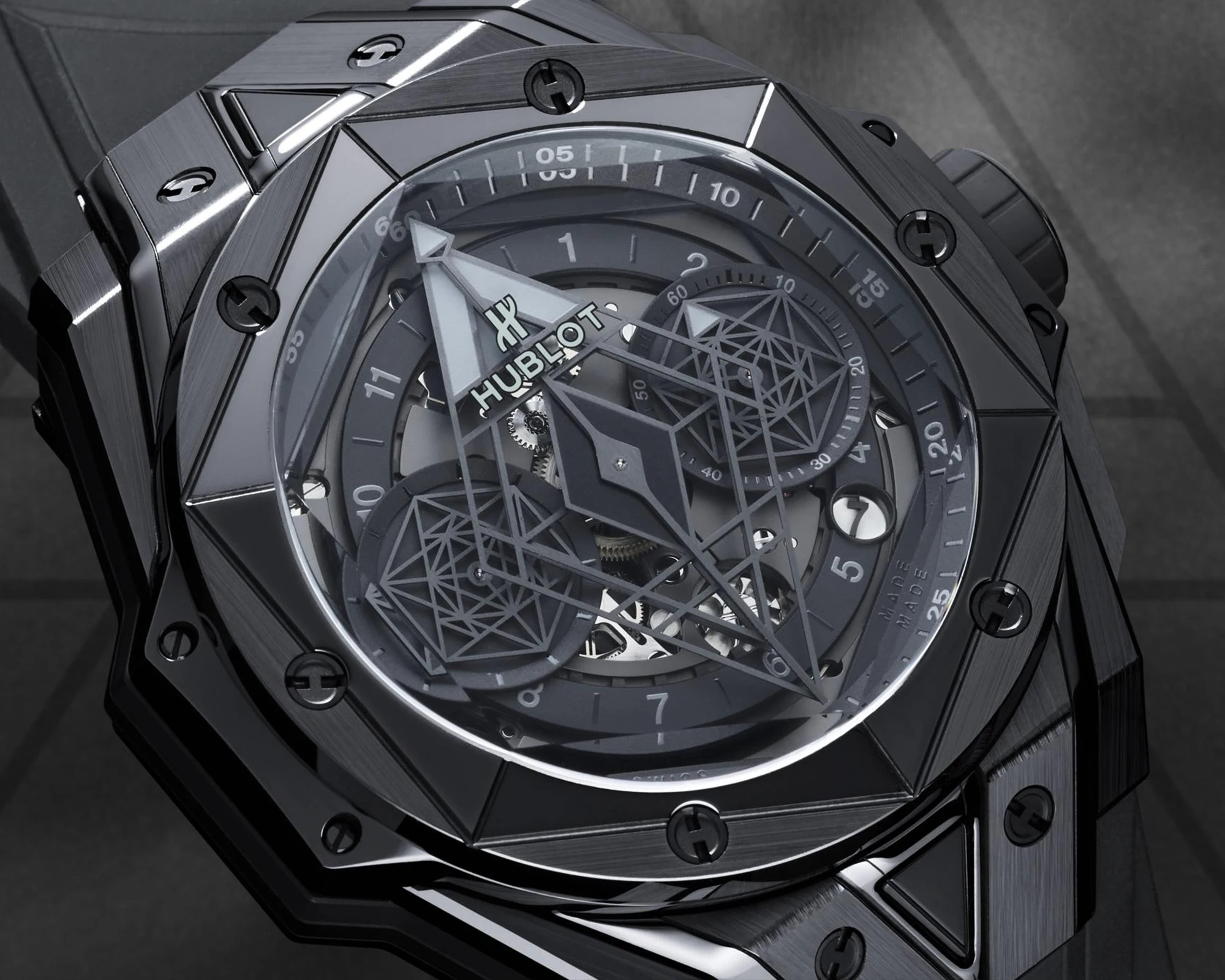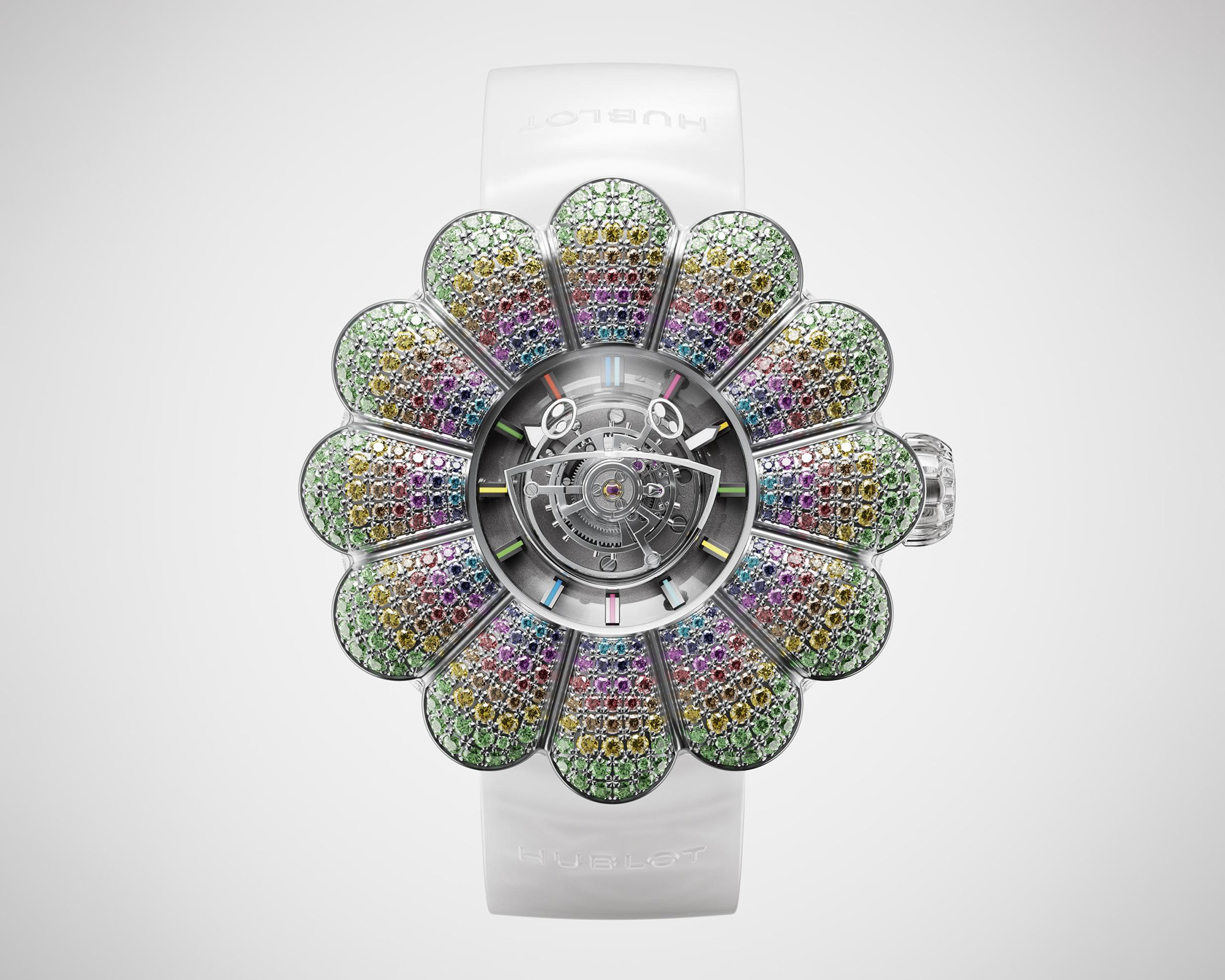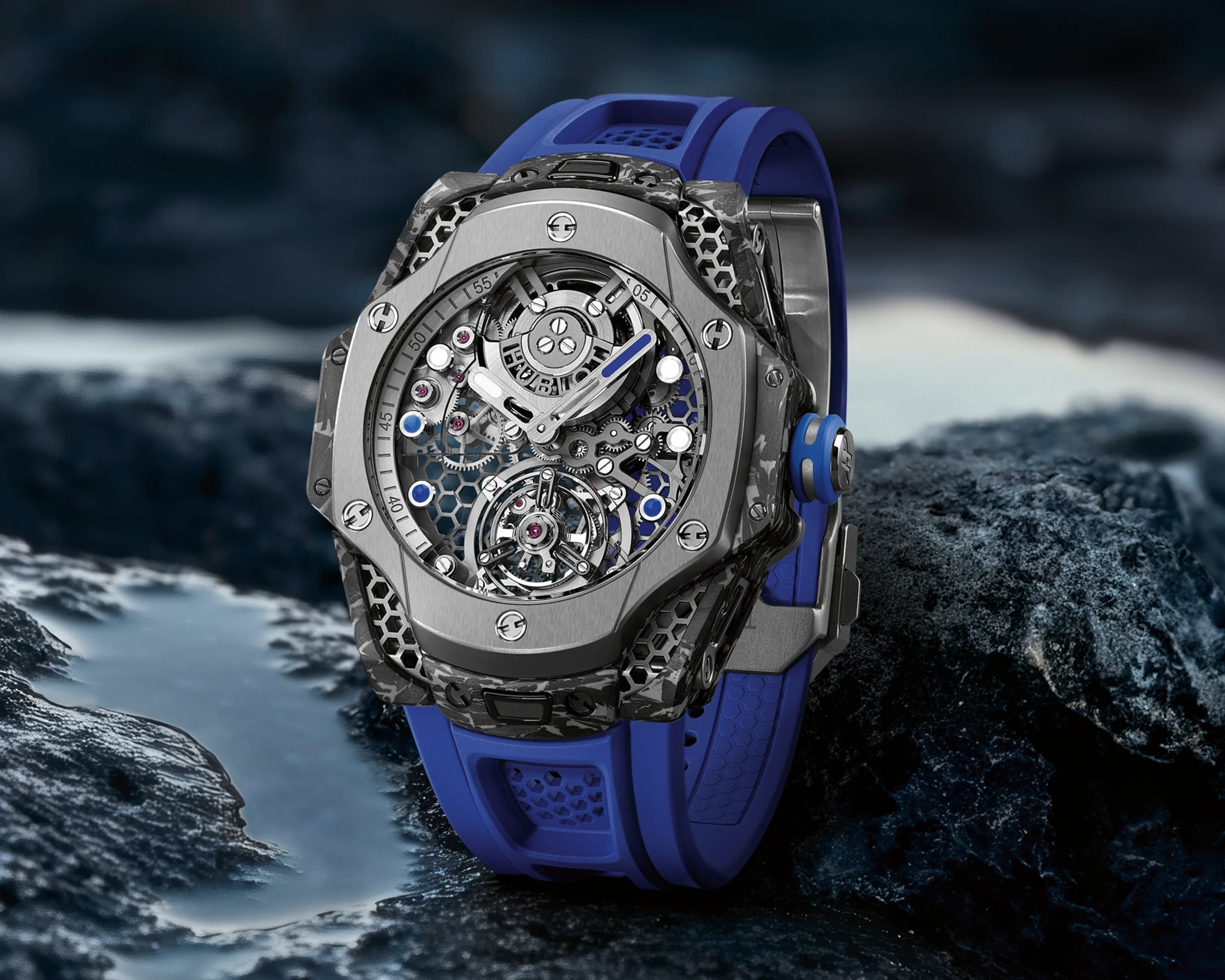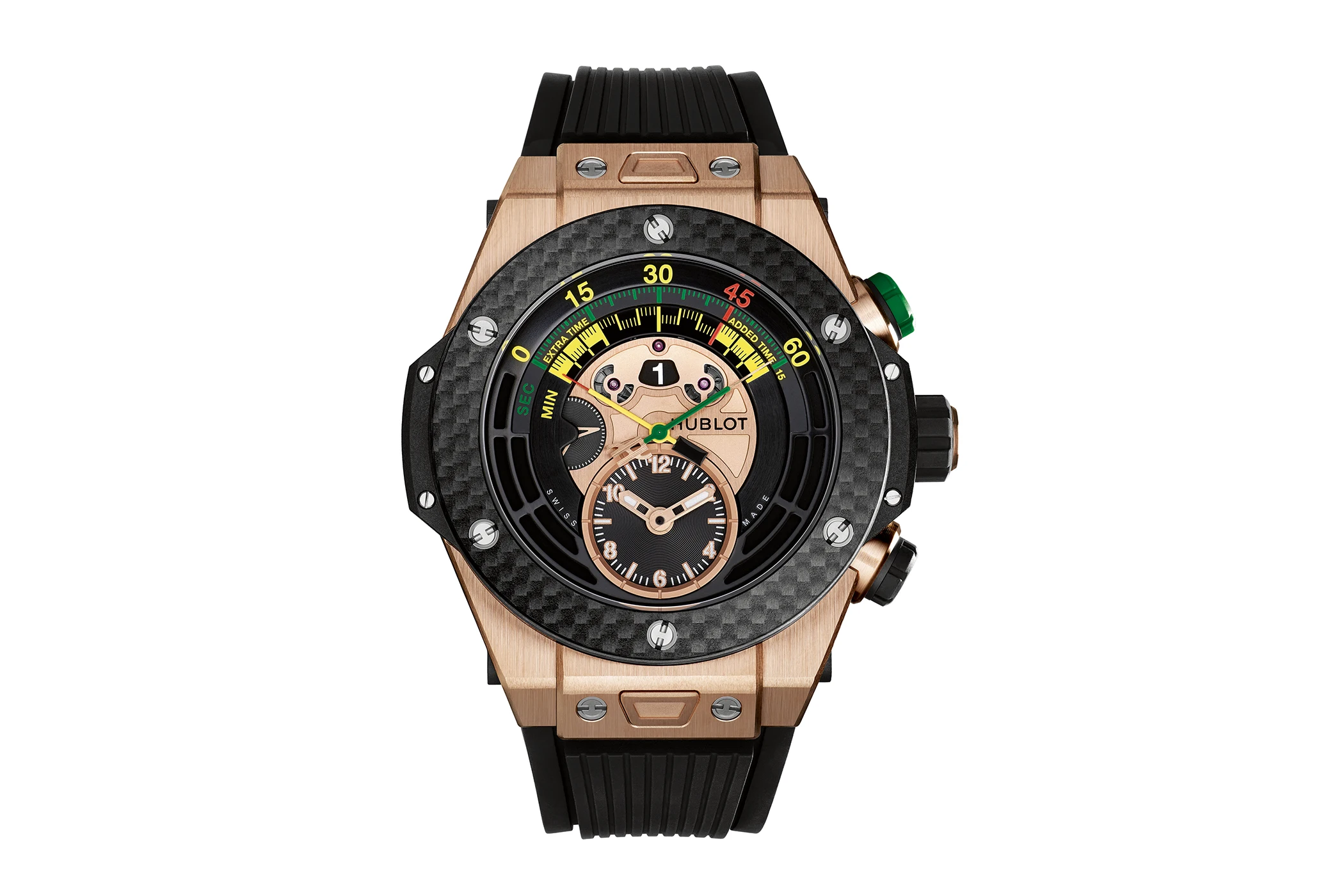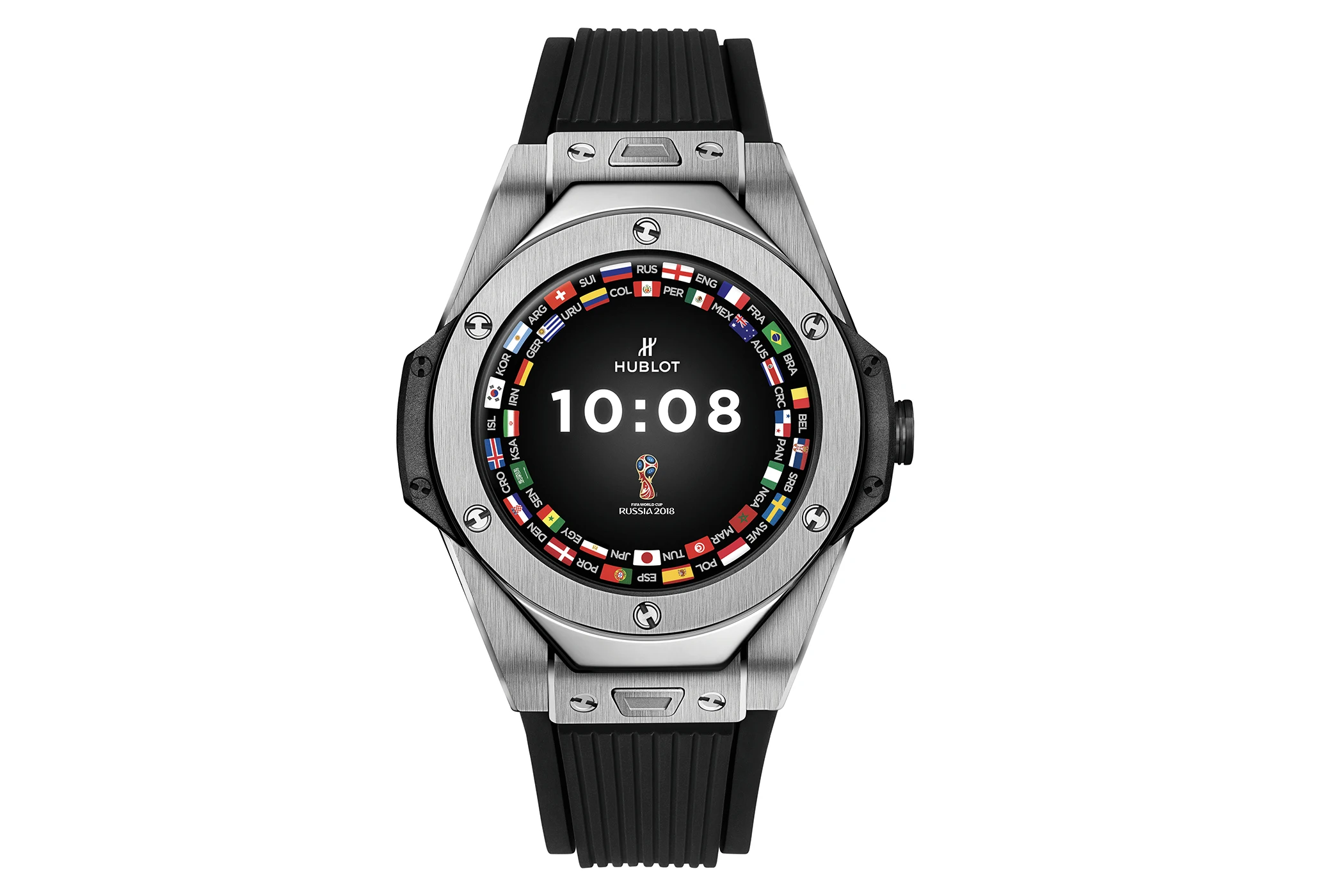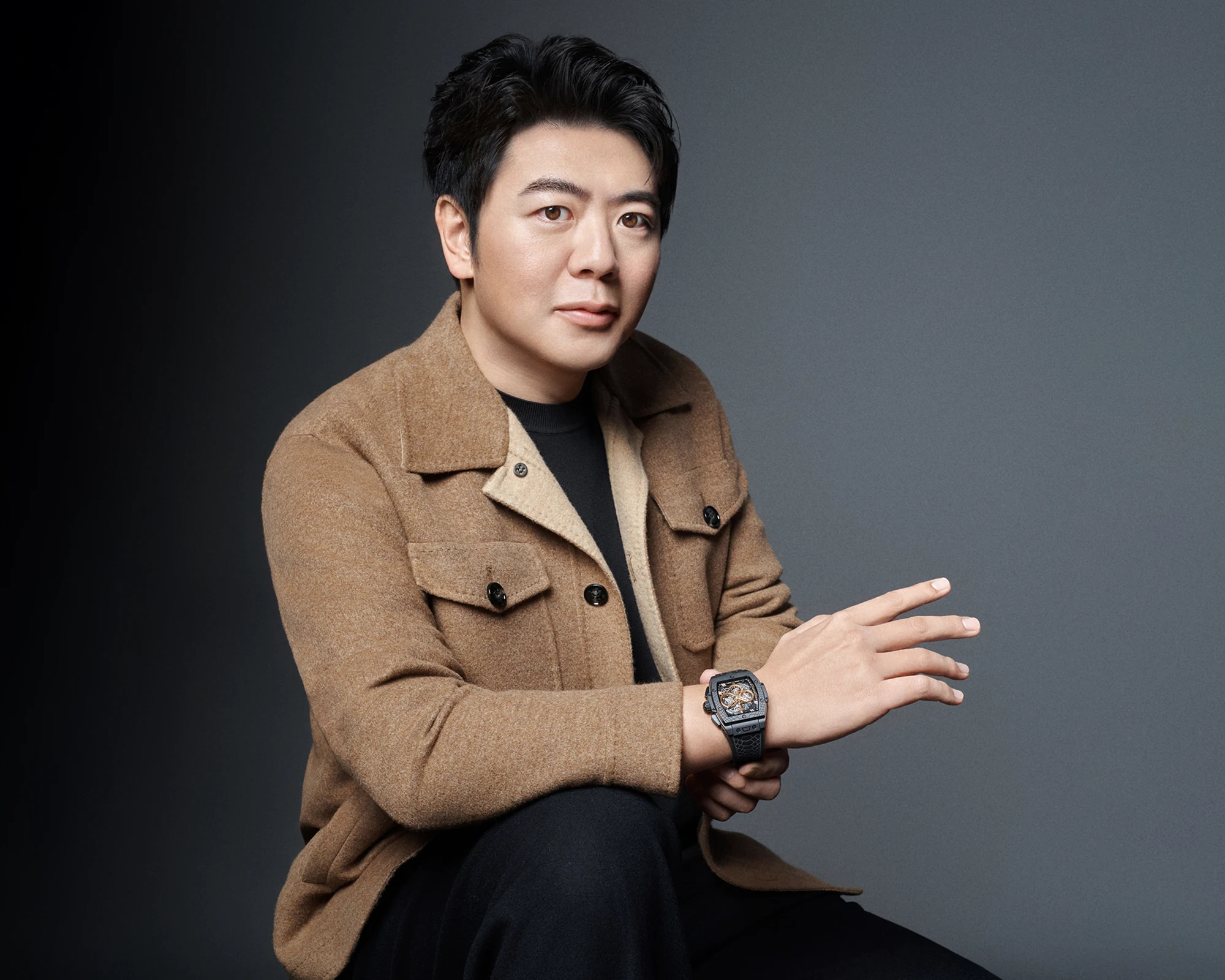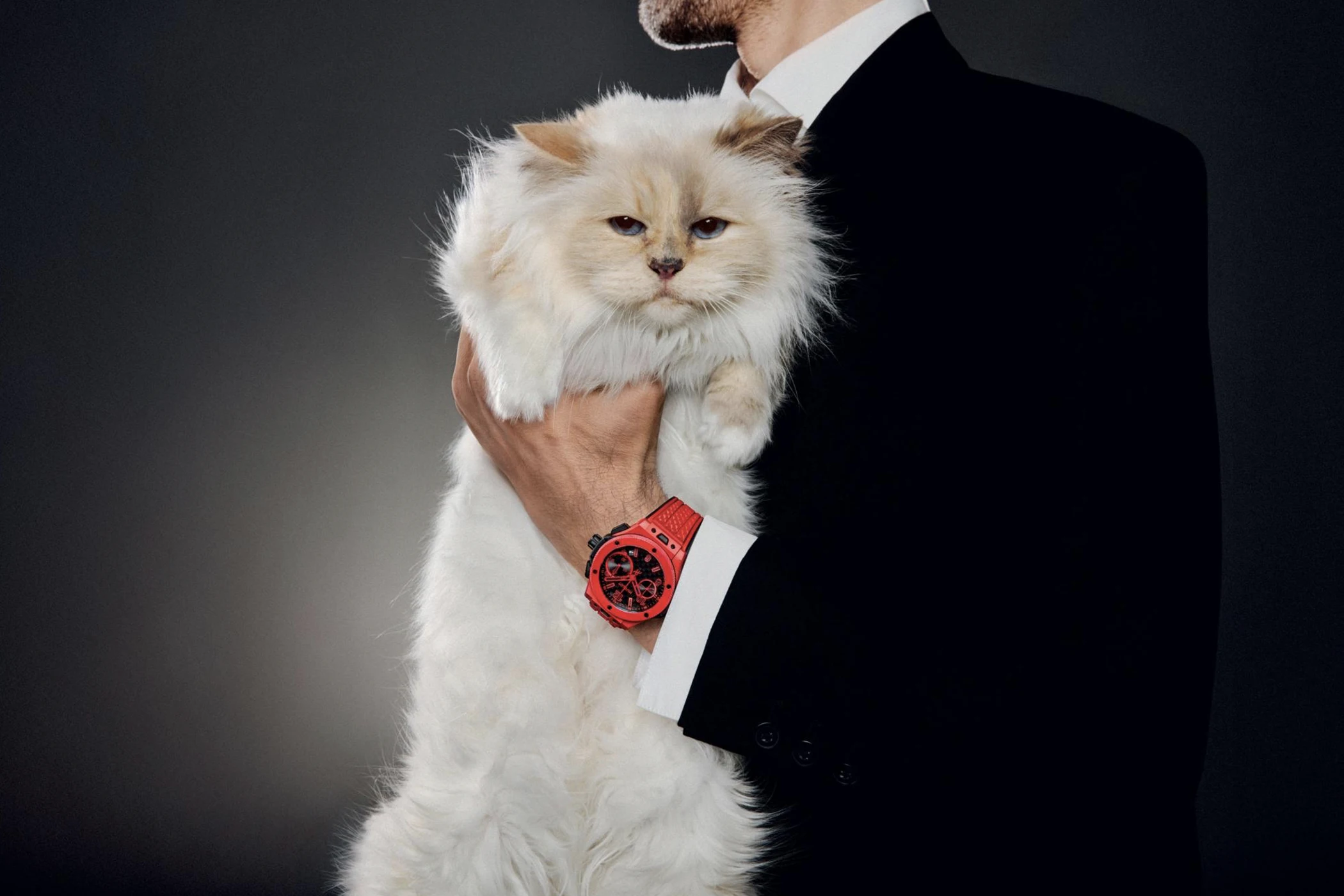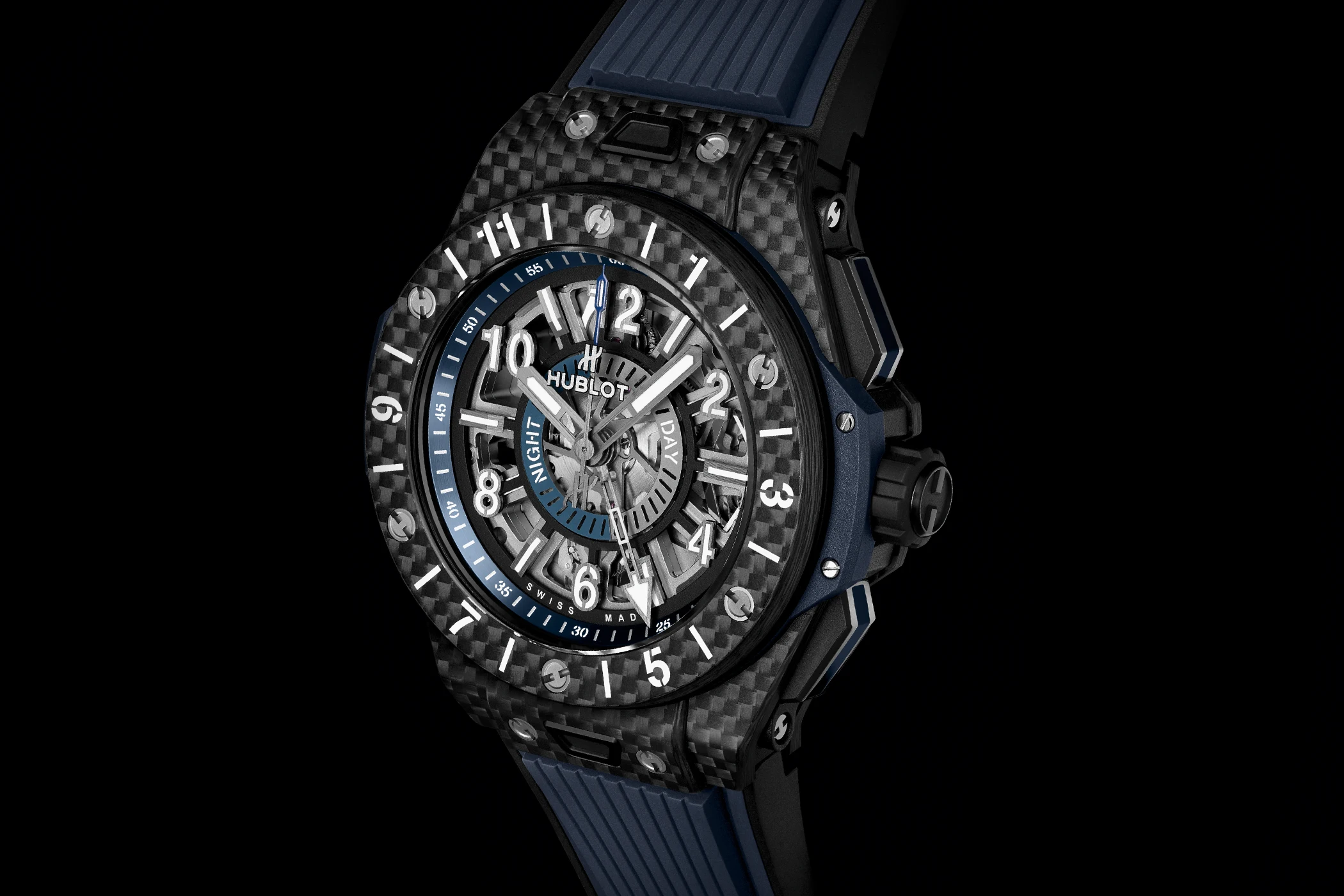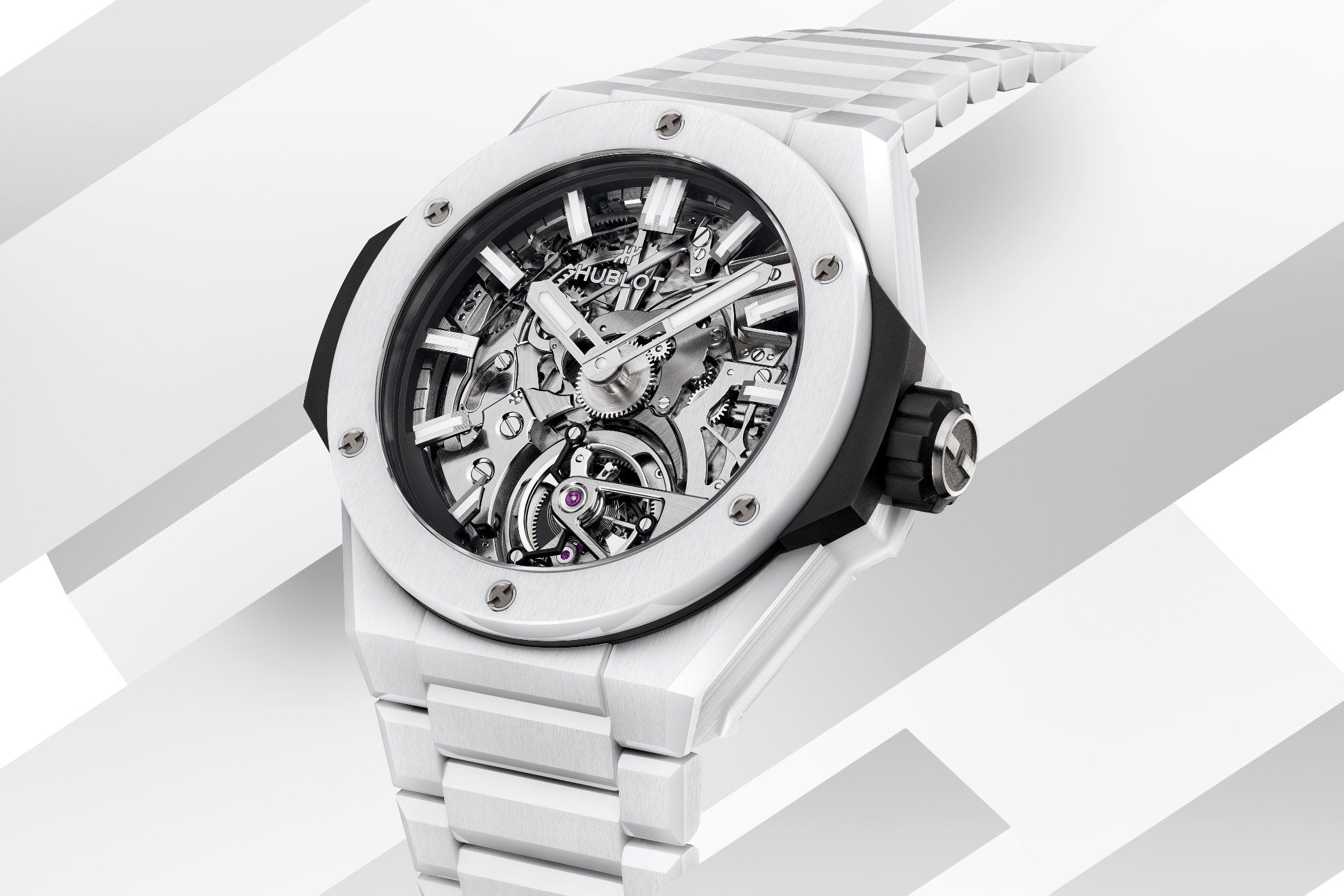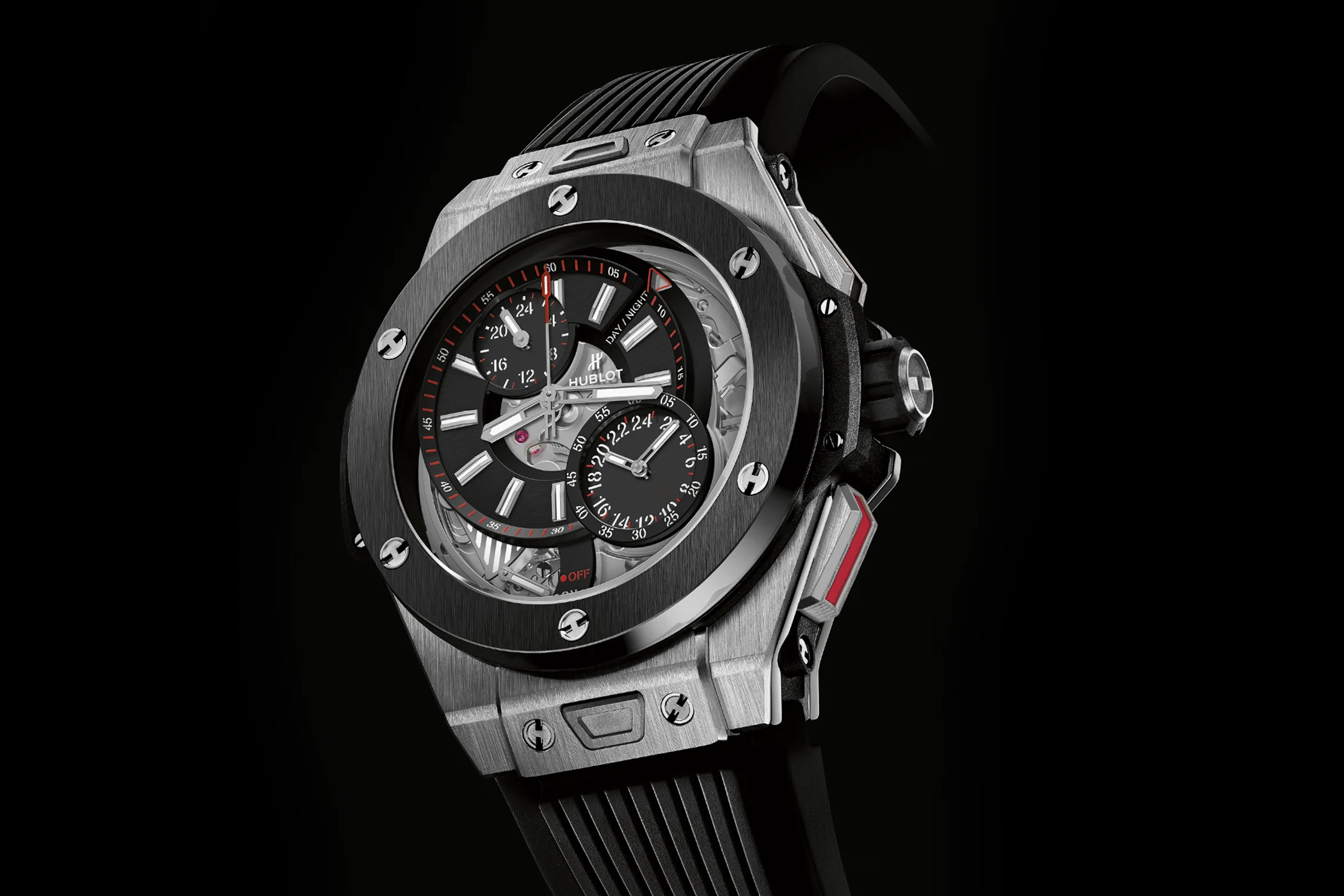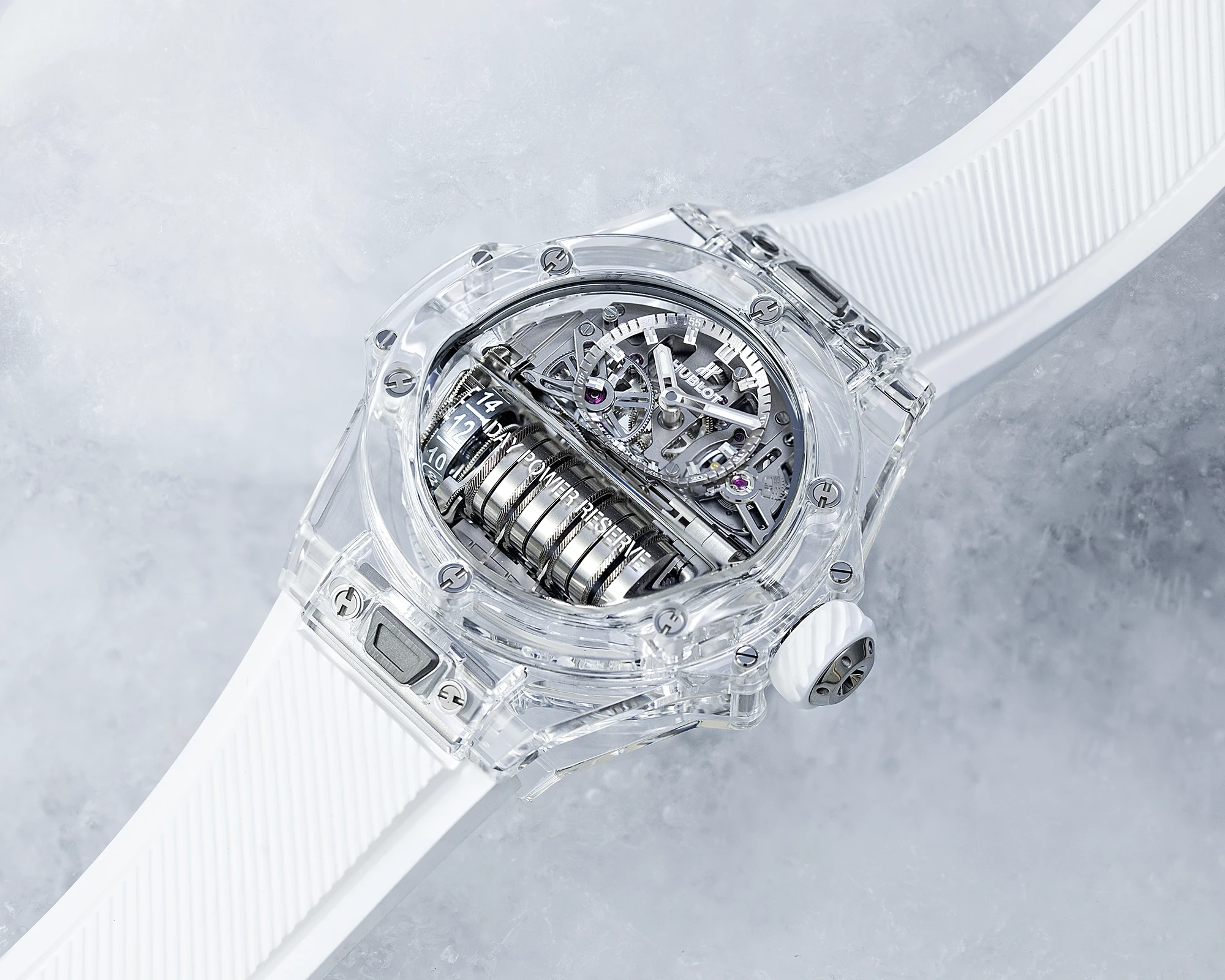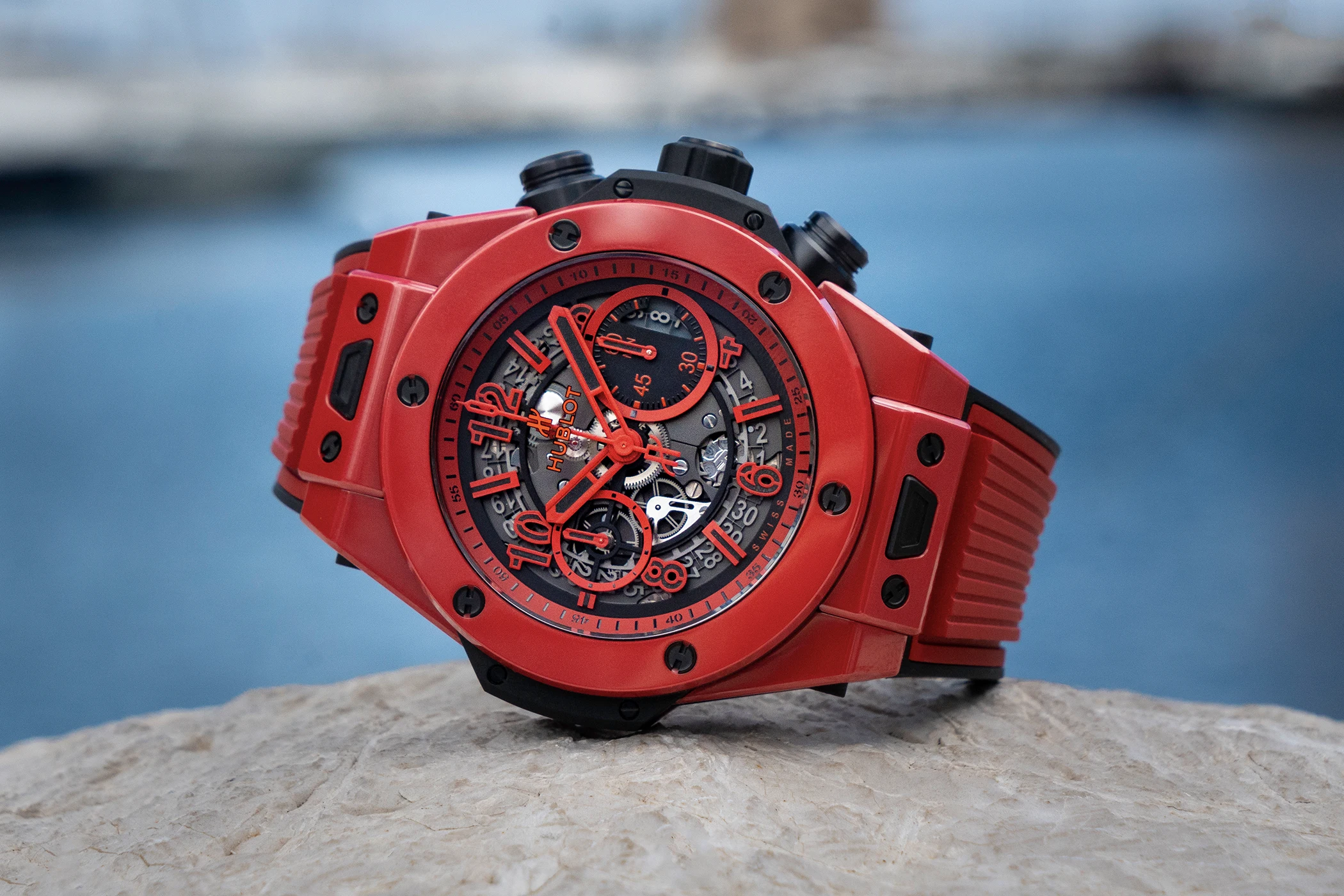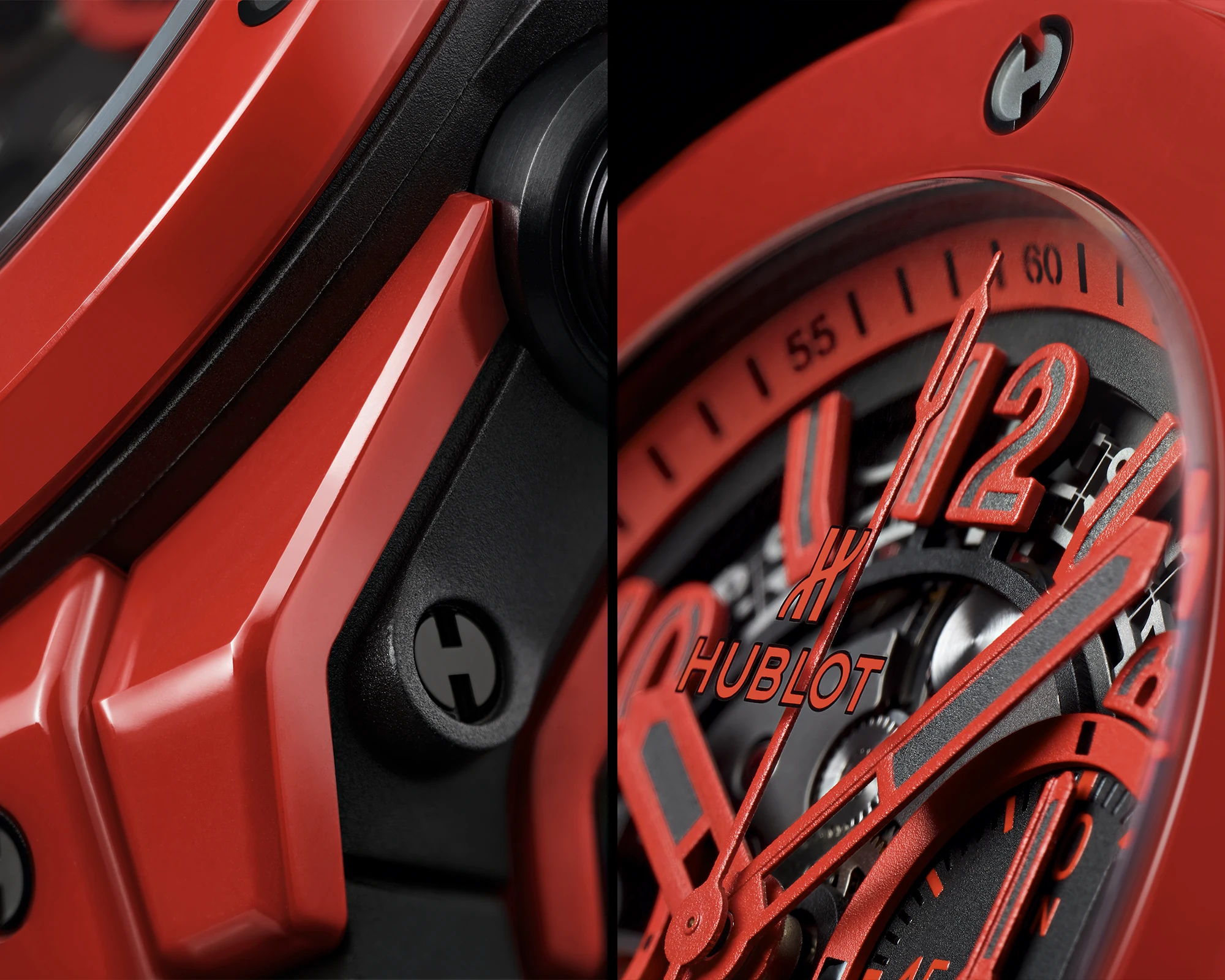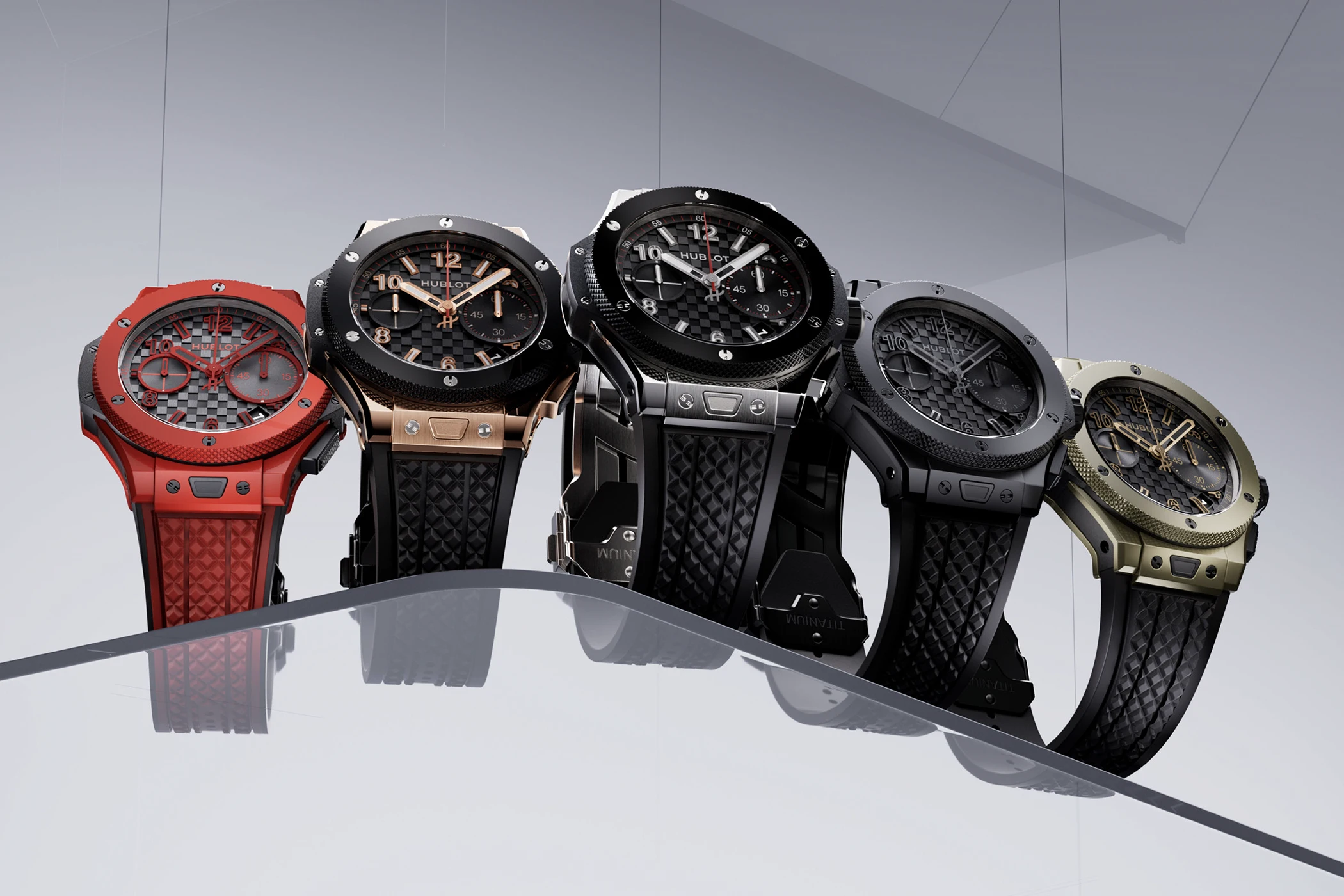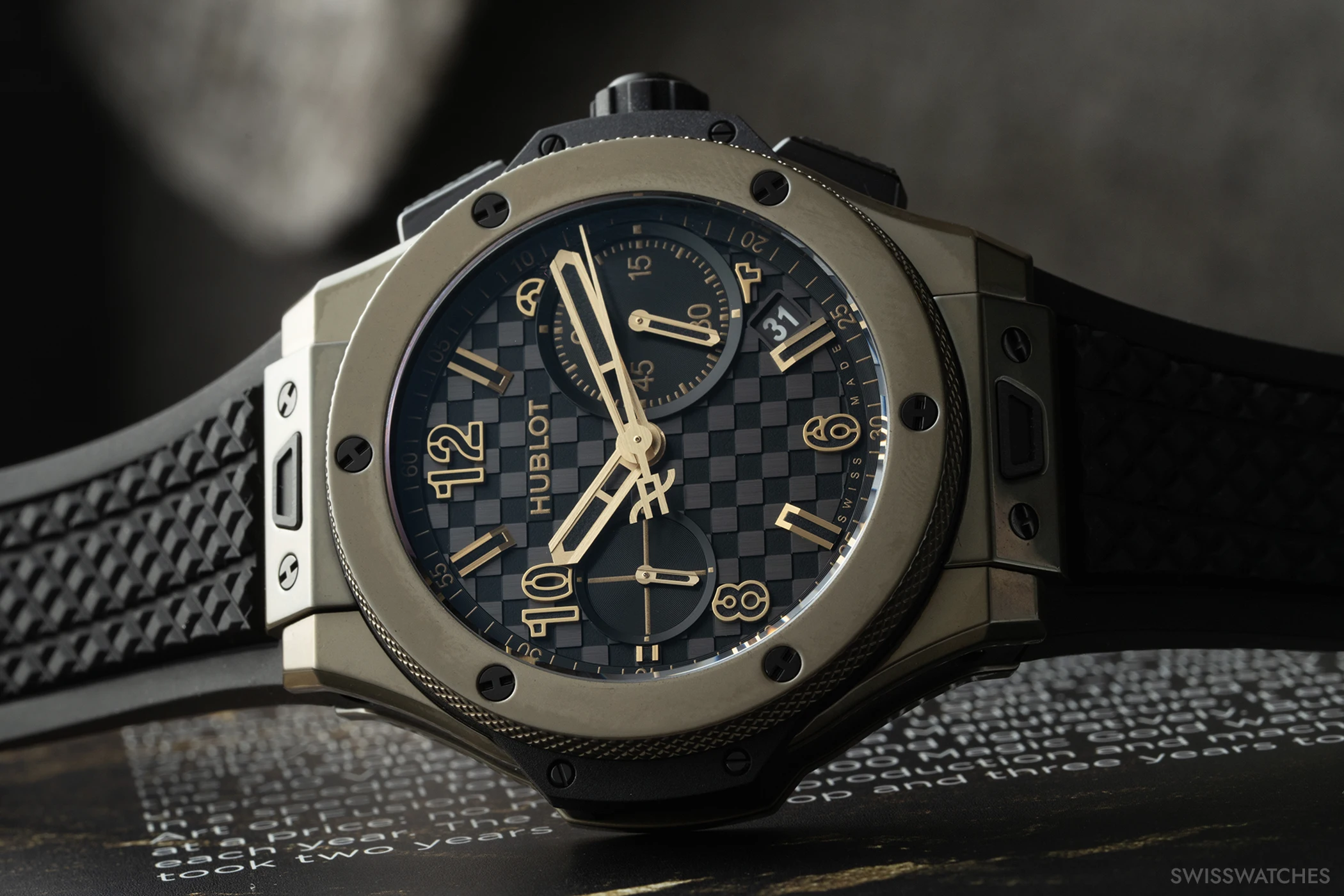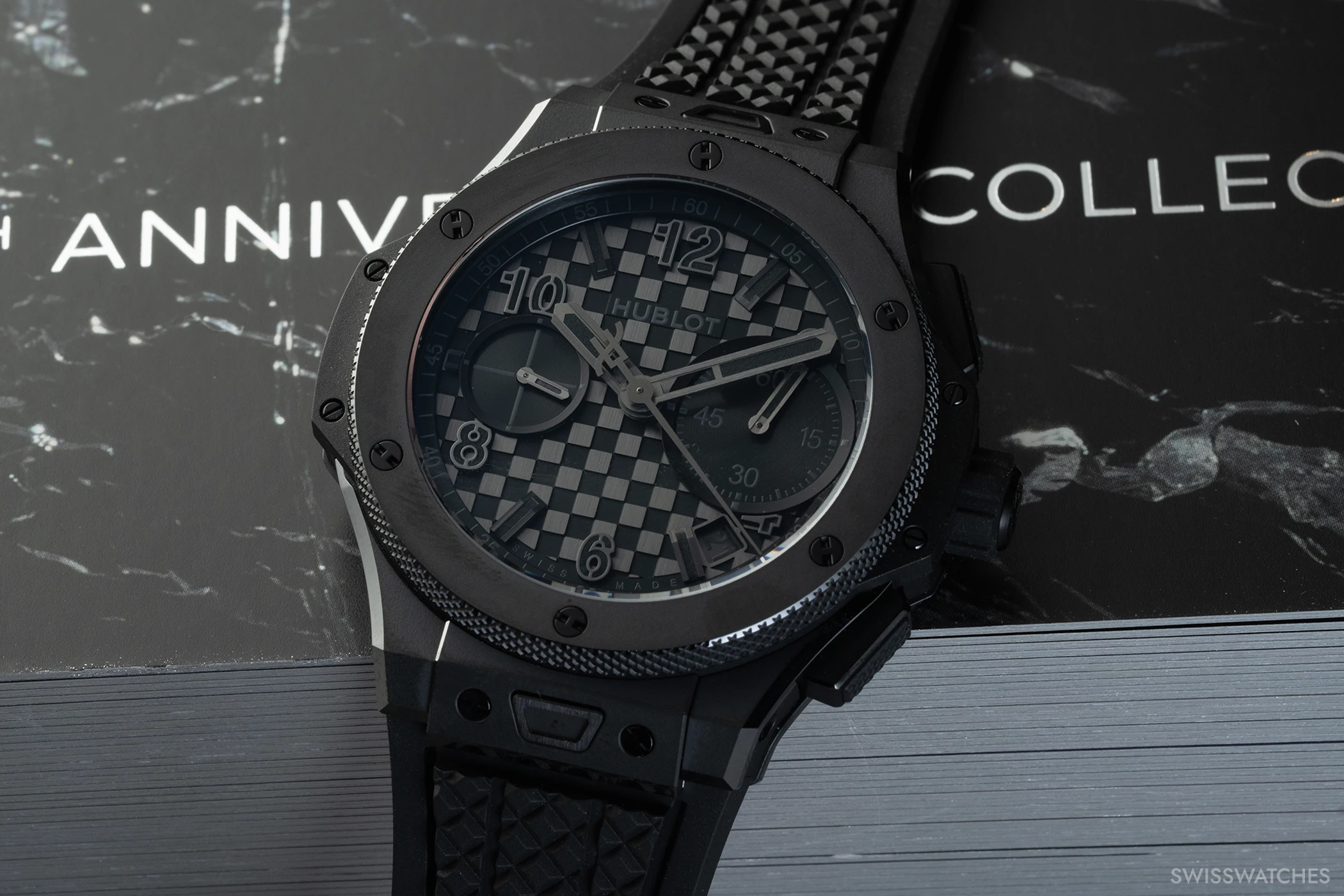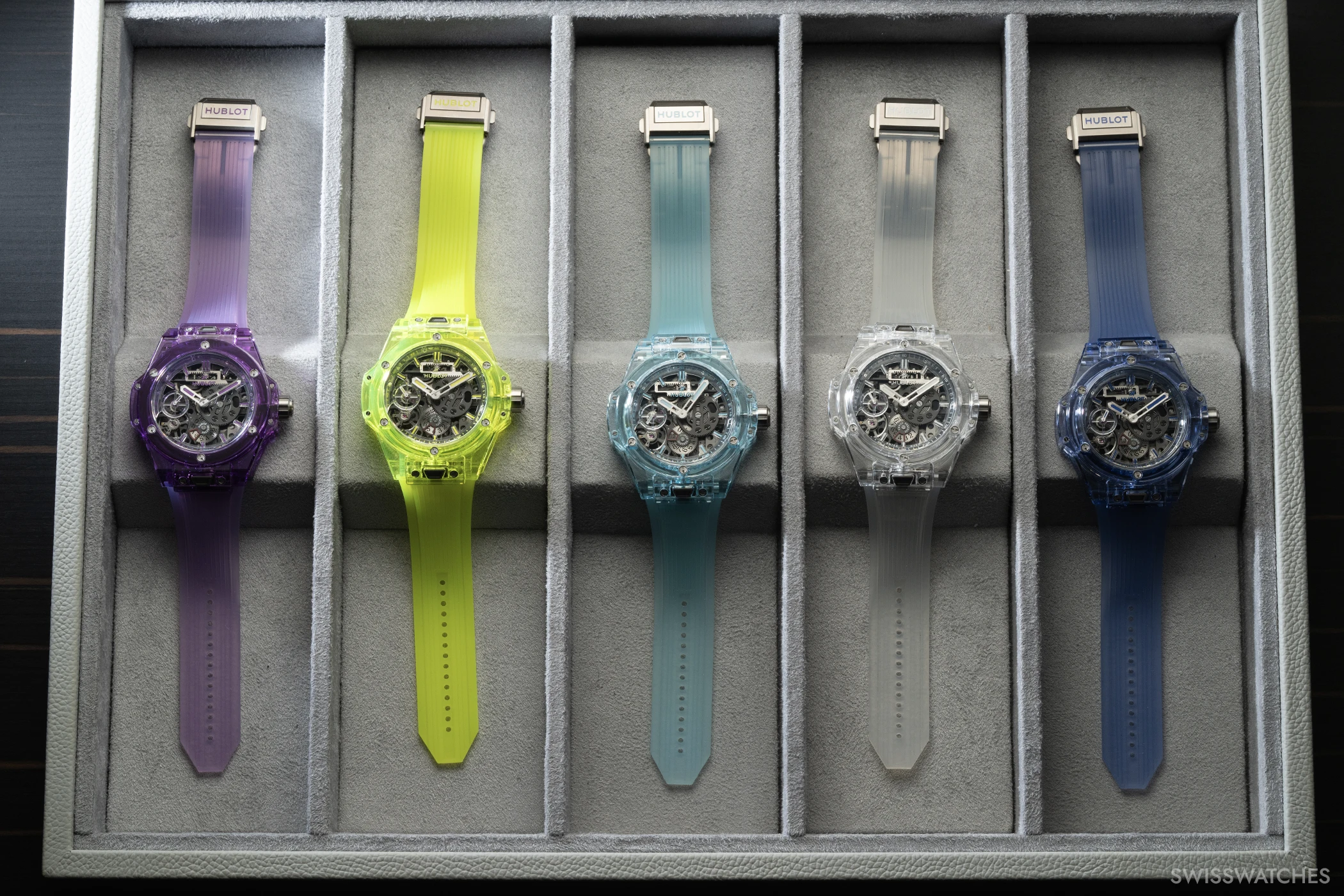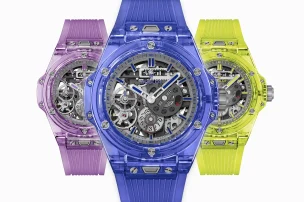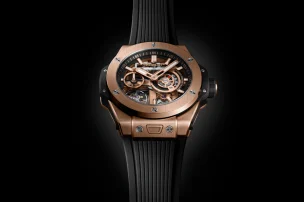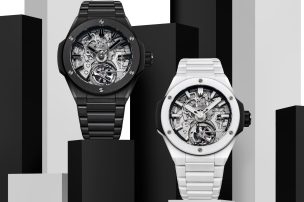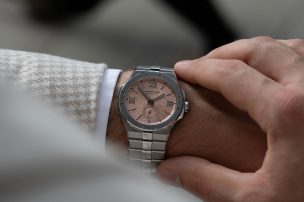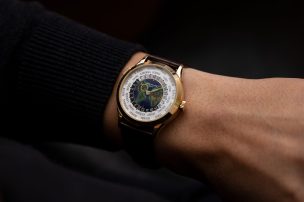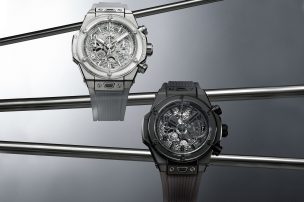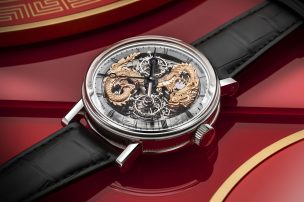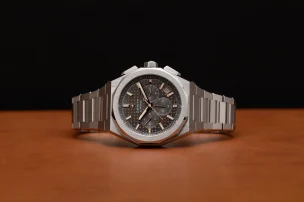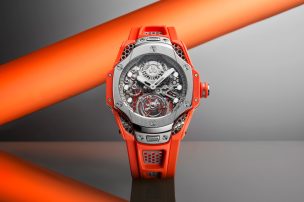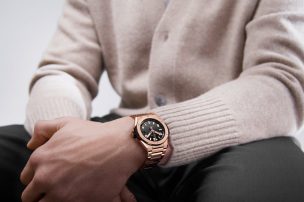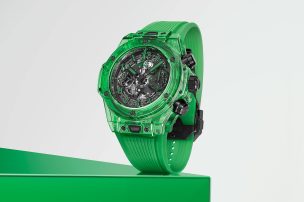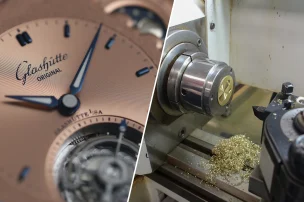
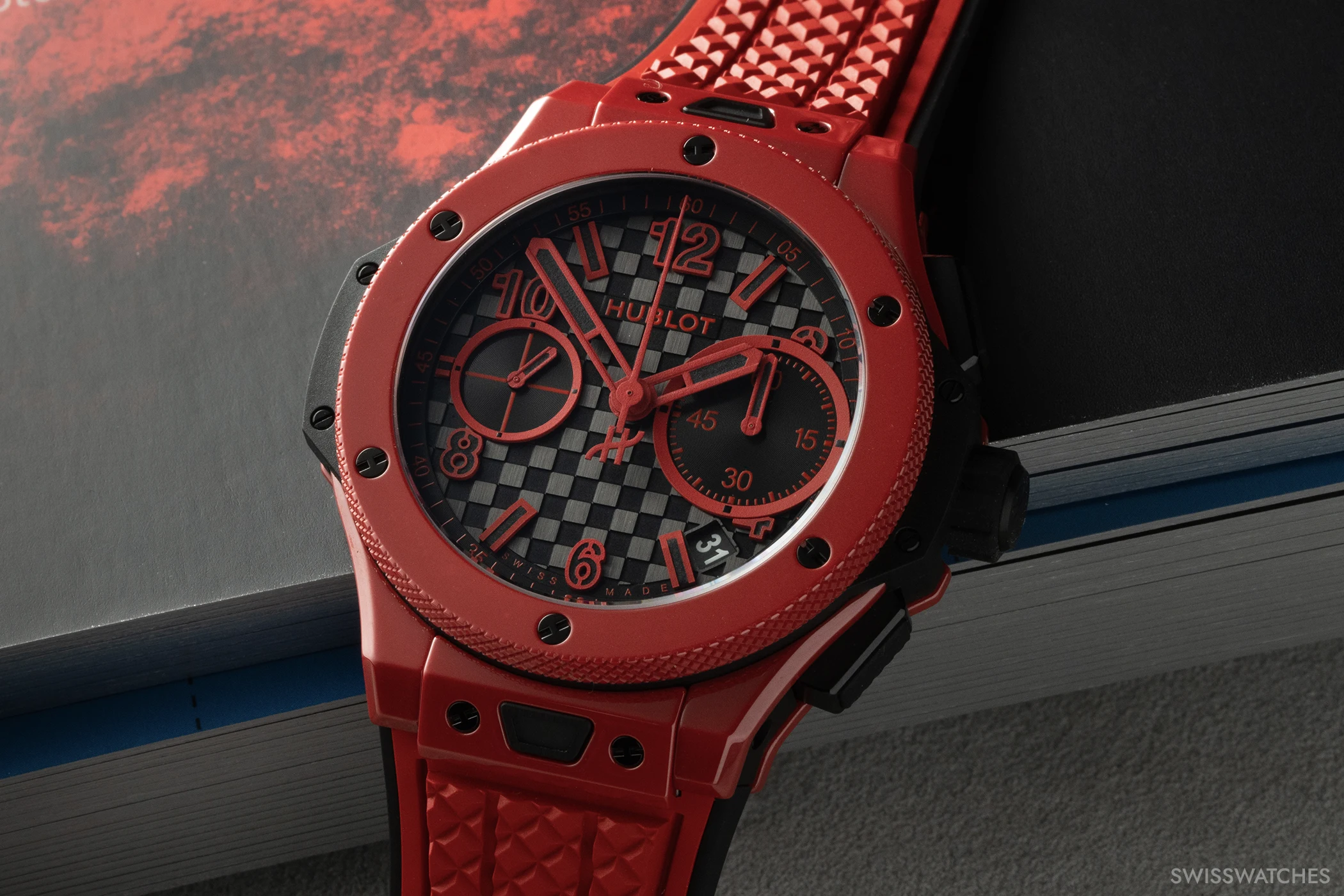
20 Years of Big Bang: How Hublot is Revolutionising The World of Watches
When Hublot unveiled the Big Bang in 2005, the model caused a revolution in the world of watchmaking. The timepiece embodied a new way of thinking by moving away from a retrospective view of tradition and towards a forward-looking form of luxury. While many manufacturers draw their designs from the past and place emphasis on values such as craftsmanship, movement decoration, or classical complications, Hublot took a radically different approach with the Big Bang: technology, innovation, and modern design became the new benchmark.
Uniting what doesn’t naturally belong together
At first glance, the Big Bang sets itself apart from other luxury timepieces. Its architecture is complex, with the case made up of more than 50 individual components. This design also allows for the fusion of diverse and unconventional materials. The combination of carbon and gold, ceramic, and stainless steel, or even denim and precious stones may seem bold at first but it is precisely this contrast that gives the watch its unique appeal.
The provocation is very much intentional: the Big Bang is designed to attract attention – and it isn’t trying to please everyone. But that doesn’t mean it’s all show and no substance. On the contrary, designing, producing, and finishing such a complex case to the required standard demands significantly more effort and expertise than simply turning and polishing a standard case. The attention to detail is evident in features such as the visible screw heads on the bezel, styled in the shape of a stylised Hublot logo. The applied numerals follow a stencil aesthetic, reminiscent of those used on military vehicles. At 44.5 millimetres, the watch was considered quite large at the time, making it all the more eye-catching.
Behind Hublot’s unconventional approach to materials and design lies a clear concept: the ‘Art of Fusion’. This phrase was coined by Jean-Claude Biver, the visionary figure behind the brand’s modern direction. Hublot embraces a philosophy that brings together apparent opposites – whether materially or symbolically. For example, the brand combines materials that could hardly be more different, such as natural rubber being paired with precious metals like gold. The idea behind it: true innovation arises when boundaries are pushed and bold combinations are made. The clash of styles is not a side effect; it’s part of the strategy.
Design > function
Even the very first Big Bang in 2005 was polarising: its striking 44.5-millimetre size, the ceramic bezel with stylised Hublot screw heads and waffle-patterned edge, the stencil numerals on a carbon-fibre-look dial, and the complex case with a black central section that appeared to extend the waffle-patterned rubber strap through the watch itself. All of it was rather challenging for the tradition-bound world of horology.
Part of the case was also made from black plastic – an absolute taboo at the time. There were two versions: a steel case with a ceramic bezel and rubber strap, and a gold case with a ceramic bezel and rubber strap. Even though the very first Hublot models had already combined gold and rubber back in 1980, this pairing was still far from being established.
With the ‘All Black’ models, Hublot once again caused a stir in 2006 and set another trend. In these timepieces, case, dial, hands, and indices merge into an entirely black watch. While legibility takes a back seat here, the design is clearly the main focus. Despite the monochrome look, a mix of polished and satin-finished surfaces creates striking complexity. This play on contrasts continues throughout: the glossy Hublot logo stands out against the matte dial, while the brand name appears in relief on the rubber strap. Ceramic ensures scratch-resistant surfaces. Inside ticks the HUB44 automatic chronograph movement, developed in collaboration with La Joux-Perret. Its architecture is based on the Valjoux 7750, but has been modified and modernised.
Hublot also takes an unconventional approach to women’s watches: embroidered skull motifs on the strap and dial break with traditional ideas of feminine watch aesthetics.
The Big Bang $5 Million also drew global attention in 2012. At the time, it was the world’s most expensive watch, set with 1,252 baguette-cut diamonds totalling over 100 carats. It took 14 months to source, cut, and set the stones. Beyoncé famously gifted the piece to her husband Jay-Z for his birthday.
Modern mechanics: Unico
Until 2013, Hublot’s philosophy had focused primarily on design, materials and case complexity. But with the introduction of its in-house Unico movement, the brand reached an entirely new level: from that point onwards, the guiding principle of the Art of Fusion as a harmony between tradition and innovation extended into the movement itself. The Unico calibre was developed from the outset to be visible through a skeletonised dial in the Big Bang, offering entirely new creative possibilities and a depth and dimensionality rarely seen in watches.
The chronograph mechanism, including the column wheel, was moved to the dial side to maximise visibility of the movement. Even the date ring is skeletonised, ensuring that nothing obscures the view. The Unico calibre embodies Hublot’s philosophy by uniting past and future: it is a traditional mechanical in-house movement with a thoroughly modern architecture, incorporating cutting-edge elements such as silicon components, which the brand started using before they became commonplace. Classical watchmaking is reimagined here through avant-garde design and advanced technology.
This high level of complexity now extends to the inside of the watch. A slim chapter ring remains as a vestige of the dial, leaving the skeletonised movement fully exposed. Gears, levers, screws – the mechanics are on full display, reinforcing the Big Bang’s industrial-mechanical character. Hublot’s aim is not to reject watchmaking tradition but quite the opposite. Many details echo the craft’s origins: the finely worked surfaces, alternating satin and polished finishes, and the intricacy of even the smallest components. But all of this is reinterpreted through a modern, technical lens.
As always with Hublot, functionality is never an afterthought. The movement features a flyback function, allowing the chronograph to be restarted without first stopping and resetting it, and offers an impressive 72-hour power reserve.
Hublot’s proprietary One Click strap-change system is also considered one of the best on the market, thanks to its ease of use. The brand doesn’t attempt to hide the mechanism, but rather highlights it: the release button is prominently positioned at the lugs, with a distinctive trapezoid shape, raised satin-finished border, and recessed bead-blasted centre. Here, functionality is presented as an intricate design feature.
Innovative materials
Hublot doesn’t just experiment with existing materials; it also develops its own. A prime example is ‘Magic Gold, a fusion of 18-carat gold and high-tech ceramic. Introduced in the Big Bang in 2015, this material is an exceptionally scratch-resistant precious metal, harder than anything previously known as gold. Even diamonds can barely leave a mark. Gold, the symbol of traditional values, meets high-tech ceramic, the embodiment of technological progress. The result is a symbolic fusion that runs through the entire Big Bang concept.
The Big Bang Unico Sapphire proves to be even more resilient. In 2016, Hublot succeeded in crafting a case from completely scratch-resistant sapphire crystal. And true to form, the brand embraces the theme of transparency throughout: in addition to the case and chapter ring, even the colourless strap allows a deep view into the heart of the watch.
A canvas for artists
Hublot does not regard the Big Bang as an untouchable design icon, but as an open concept. That’s why the brand enjoys collaborating with a wide range of artists, allowing them to have a significant influence on the design.
For instance, the partnership with Ferrari and its design chief Flavio Manzoni led to striking reinterpretations of the Big Bang: the bezel, pushers, and hands were adapted to Ferrari’s design language, and in some models the bezel was made from the same carbon-ceramic composite used in the brand’s high-performance brake discs.
Equally intriguing was the collaboration with design studio Italia Independent. For their joint Big Bang models, they used a high-tech composite of fibreglass and aluminium with a futuristic appearance called Texalium. Combined with camouflage patterns and bold colours like blue or green, the result was a distinctly fashion-forward look, highlighting how boldly Hublot breaks away from traditional style conventions.
This approach continues through various collaborations with creatives from other fields: from the geometric Sang Bleu models with tattoo artist Maxime Plescia-Büchi, to Takashi Murakami’s iconic smiling flower, and a partnership with designer Samuel Ross, who created a Big Bang featuring a uniquely honeycomb-skeletonised case.
Luxury watch and football
In addition to art and design, Hublot embraced sport early on as a platform for innovation, particularly football. It was the first luxury watch brand to form a partnership with professional international football, years ahead of the trend. As a result, the brand’s name became a regular sight on the substitution boards at World Cups and European Championships. Thus, it was impossible to miss.
But Hublot didn’t stop at sponsorship: the brand developed dedicated timepieces for the sport. One such example is the Big Bang Unico Chrono Retrograde, a watch specifically designed for football matches. It features a 45-minute counter to track each half and an additional segment for stoppage time, a genuinely practical function for football fans.
For the 2018 FIFA World Cup, Hublot introduced its first smartwatch: the Big Bang Referee 2018 FIFA World Cup. This watch was not only linked to goal-line technology to support referees, but also offered exciting features for fans. It notified users of kick-off times 15 minutes in advance, and delivered real-time updates on goals, cards and substitutions – even vibrating to celebrate a goal. Wearers could also personalise the dial and strap in their favourite team’s colours – yet another example of Hublot’s blend of emotion and technology.
Hublot also took a fresh approach to brand ambassadors, signing exceptional talents like footballer Kylian Mbappé. Yet the brand’s sporting ties go beyond football, with sprint legend Usain Bolt and tennis icon Novak Djokovic also among its distinguished ambassadors.
One of Hublot’s more unexpected partners is the renowned Chinese concert pianist Lang Lang. At first glance, the connection may seem surprising. But Lang Lang, who is an avid football fan and social media personality, doesn’t shy away from breaking tradition, even sharing a stage with heavy metal band Metallica. His ability to unite seemingly opposing worlds makes him an ideal fit for Hublot.
And the face of the Big Bang’s 20th-anniversary campaign? None other than Choupette – the world’s most pampered cat. Karl Lagerfeld famously created an Instagram account for his beloved Birman cat, which now boasts 271,000 followers. Appointing a cat as a brand ambassador is just the kind of bold, conversation-starting move that perfectly reflects Hublot’s flair for provocation.
It’s complicated
Over time, a wide range of horological complications have found their way into the Big Bang, including entirely unique mechanisms developed by Hublot itself. One such example is the Big Bang Unico GMT, in which Hublot replaced the chronograph element of the Unico movement with an in-house module for displaying a second time zone. A similar approach was taken with the Big Bang Unico Chronograph Perpetual Calendar, where the Unico’s flyback chronograph was substituted for a proprietary chronograph with perpetual calendar functionality.
In 2022, Hublot achieved a world first with the Big Bang Integral Tourbillon Cathedral Minute Repeater Ceramic, successfully integrating a sonorous minute repeater into a ceramic case. The Big Bang Alarm Repeater, featuring both an alarm function and a second time zone, also demonstrated impressive complexity.
Three standout complications remain in the collection to this day: the Big Bang Meca-10 features a hand-wound movement developed by Hublot, offering an impressive 10-day power reserve, and a sophisticated display. The even more visually striking Big Bang MP-11 houses a manufacture movement with seven vertically aligned barrels, delivering an extraordinary 14-day power reserve.
A particularly practical innovation is the Big Bang Unico Golf: this mechanical timepiece, based on the Unico movement, allows the wearer to count shots per hole and keep track of the total number of strokes played during a round of golf – all at the push of a button.
Red ceramics
Hublot has used ceramic as a scratch-resistant case material for the Big Bang, particularly for the bezel, since the very beginning. However, producing a vivid, luminous red ceramic was long considered impossible. After four years of research, Hublot succeeded in 2018 in creating this colour in ceramic. The resulting material is even more scratch-resistant than standard high-tech ceramic, achieving 1500 Vickers compared to the usual 1200. The breakthrough lay in finding the right balance of temperature and pressure during the sintering process, and Hublot’s research team discovered how to prevent the colour pigments from burning off. The fully polished ceramic case components, contrasted with matte black elements, make the red appear even more vibrant and intense.
To mark the 20th anniversary of the Big Bang, Hublot is unveiling models with coloured sapphire cases. The brand is also presenting five timepieces as a tribute to key milestones in the collection’s history. All of them reinterpret the very first Big Bang, featuring a woven-look dial and the iconic lozenge pattern on the bezel and strap. Inside ticks the Unico manufacture calibre, developed especially for the Big Bang.
Each of the five models also celebrates another major highlight in the collection’s evolution: The versions in titanium and ceramic, as well as in King Gold and ceramic, recall the very first Big Bang references. The All Black, Magic Gold and Red Ceramic models honour further landmark innovations in the series. A golden rotor marks each of these 20th-anniversary pieces as part of the jubilee edition.
In 2025, to further celebrate the Big Bang’s 20th anniversary, Hublot will release a unique set of five exceptional timepieces, each a one-off with a complex movement: two Big Bang Tourbillon Automatic models in sapphire and red ceramic cases; a Big Bang Tourbillon Chronograph in a blue sapphire case; a Big Bang Tourbillon Chronograph Cathedral Minute Repeater housed in ‘Frosted Carbon’; and a Big Bang Integrated Tourbillon Cathedral Minute Repeater in blue Texalium.
The watch as Big Bang
The name Big Bang resonates in two ways. On the one hand, each model makes an explosive impact: loud and attention-commanding, sometimes even startling. On the other, the watch represents the cosmic Big Bang itself, the moment of origin. It defines the very shape of Hublot’s universe and gives rise to a bold, colourful cosmos all of its own.
